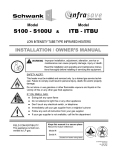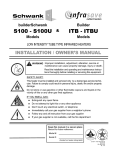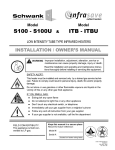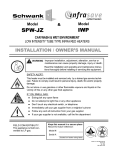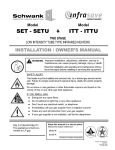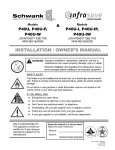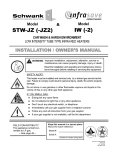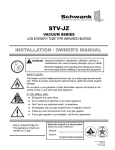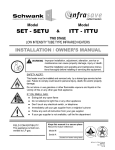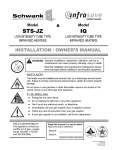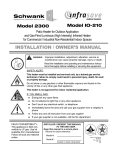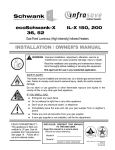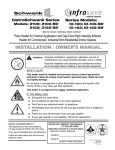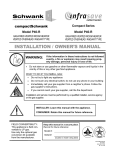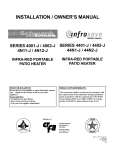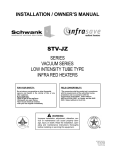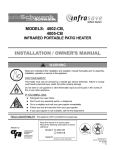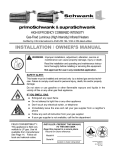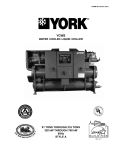Download Schwank S100U Owner`s manual
Transcript
Model Model S100 - S100U & ITB - ITBU LOW INTENSITY TUBE TYPE INFRARED HEATERS INSTALLATION / OWNER’S MANUAL WARNING Improper installation, adjustment, alteration, service or maintenance can cause property damage, injury or death. Read the installation and operating and maintenance instructions thoroughly before installing or servicing this equipment. SAFETY ALERT: This heater must be installed and serviced only by a trained gas service technician. Failure to comply could result in personal injury, death, fire and/or property damage. Do not store or use gasoline or other flammable vapours and liquids in the vicinity of this or any other gas fired appliance. IF YOU SMELL GAS: Extinguish any open flame Do not attempt to light this or any other appliance Don’t touch any electrical switch, or telephone Immediately call your gas supplier from a neighbor’s phone Follow any and all instruction from your gas supplier If your gas supplier is not available, call the fire department FIELD CONVERTIBILITY: This appliance is field convertible to LP gas. Keep this manual in a secure place . Record for future reference: Model #: Serial #: (located on heater rating label) S100/ITB I&O Manual IM101230 RD: SEP 2013 RL: 8B- BA NOTICE: This manual is current for this product. Occasional revision of the product Certification Standard may require changes to the product and/or this manual. This publication, or parts thereof, may not be reproduced in any form, without prior written consent from The Manufacturer. Unauthorized use or distribution of this publication is strictly prohibited. Schwank Group Schwank and InfraSave brands 5285 Bradco Boulevard Mississauga, Ontario,L4W 2A6 PO Box 988, 2 Schwank Way Waynesboro, Georgia 30830 Customer & Technical Services Phone: 877-446-3727 Fax: 866-361-0523 e-mail: [email protected] www.schwankgroup.com www.infrasave.com S100/ITB I&O Manual IM101230 RD: SEP 2013 RL: 8B- BA 2 S100 - S100U and ITB - ITBU SERIES GAS FIRED INFRARED LOW INTENSITY TUBE TYPE TABLE OF CONTENTS TOPIC TOPIC .........PAGE ……...PAGE 13. GAS SUPPLY ..................................................31 INSTALLATION HEATER EXPANSION.....................................32 IMPORTANT INFORMATION - READ FIRST FLEXIBLE GAS CONNECTION.......................33 APPLICATION ..............................................4 14. ELECTRICAL AND THERMOSTAT.................34 HEATER EXPANSION ...........................5, 31 GAS CONNECTION ...............................5, 31 See also “Flexible Gas Connection”......31 15. HIGH ALTITUDE INSTALLATION ...................34 VENTING.................................................5, 26 17. RECOMMENDED MAINTENANCE .................34 START UP ‘SMOKE’ ....................................5 18. WIRING DIAGRAMS 16. LIGHTING INSTRUCTIONS ...........................34 CLEARANCE TO COMBUSTIBLES............6 Clearances Figure & Table ........................7 STACKING HEIGHT SIGN ..........................8 LINE VOLTAGE THERMOSTAT ..................35 24 VOLT THERMOSTAT..............................36 1. LABOR REQUIREMENTS ...............................9 19. WIRING DIAGRAM MULTIPLE HEATERS PER THERMOSTAT .....................................37 2. INSTALLATION IN AIRCRAFT HANGARS .....9 20. SEQUENCE OF OPERATION.........................38 3. INSTALLATION IN COMMERCIAL GARAGES ........................................................9 21. TROUBLESHOOTING GUIDE.........................39 22. SPARK IGNITION CIRCUIT ............................41 4. INSTALLATIONS OTHER THAN SPARK IGNITER SET UP ...............................41 SPACE HEATING.............................................9 23. FLAME SENSING CIRCUIT ............................42 5. PRE-INSTALLATION SURVEY......................10 24. START– UP / COMMISSIONING SHEET .......43 6. MOUNTING CLEARANCES...........................11 PRODUCT DIMENSIONS & DATA SERVICE CLEARANCE.................................11 25. BURNER / TUBE KIT ASSEMBLY CHART HEATER PLACEMENT GUIDELINES ...........12 25A. STRAIGHT TUBE SYSTEM ………….......45 7. SYSTEMS WITH 90° & 180° ELBOWS .........12 25B. ‘U’ TUBE SYSTEM ………………………...46 ELBOW KIT DIMENSIONS .……… .... …..13 26. MODEL INPUTS, DIMENSIONS, WEIGHTS ..47 INSTALLATION DIMENSIONS 8. SUSPENDING THE SYSTEM........................14 9. BURNER & TUBE INSTALLATION ………. ..48 27A. TURBULATORS - Straight Tube....................49 STRAIGHT TUBE SYSTEM........................15 27B. TURBULATORS - ’U’- Tube...........................50 ‘U’ TUBE SYSTEM......................................17 28. HIGH ALTITUDE & ORIFICE CHART...... 50 - 51 SPECIAL COUPLING - 100, 175 & 200 Mbh..20 29. OPTIONAL ACCESSORIES..................... 52 - 55 9.4 SESMIC RESTRAINT ....................................22 30. BURNER PARTS LIST ............................ 56 - 57 9.5 HIGH WIND RESTRAINT ...............................22 30. TUBE SYSTEM PARTS LIST...........................58 9.6 SEISMIC RESTRAINT ‘U’-TUBE....................23 WARRANTY STATEMENT ............BACK PAGE 10. REFLECTOR INSTALLATION ...................... 24 11. FLUE VENTING............................................. 26 12. COMBUSTION AIR DUCT ............................ 27 3 S100/ITB I&O Manual IM101230 RD: SEP 2013 RL: 8B- BA WARNING Improper installation, adjustment, alteration, service or maintenance can cause property damage, injury or death. Read and understand this installation and operation manual thoroughly prior to assembly, installation, operation or service to this appliance. This heater must be installed and serviced only by a trained gas service technician. Do not store or use gasoline or other flammable vapours and liquids in the vicinity of this or any other gas fired appliance. Failure to comply could result in personal injury, death, fire and/or property damage. Do not store or use gasoline or other flammable vapours and liquids in the vicinity of this or any other gas fired appliance. This appliance may have sharp edges and corners. Wear protective clothing such as gloves and protective eye wear when servicing this or any other appliance. APPLICATION A gas-fired radiant tube heater may be installed for heating of commercial / industrial nonresidential spaces. It is beyond the scope of these instructions to consider all conditions that may be encountered. Installation must conform with all local building codes or, in the absence of local codes, with the National Fuel Gas Code, ANSI Z223.1/NFPA 54 in the U.S.A. or the Natural Gas and Propane Installation Code, CSA B149.1 in Canada. The latest edition Electrical Code ANSI/NFPA N0 70 in the U.S.A. and PART 1 CSA C22.1 in Canada must also be observed. Installation of a gas fired tube heater must conform to all heating installation design procedures including clearance to combustibles, connection to the gas and electrical supplies, and ventilation. This heater is not for installation in a Class 1 or Class 2 explosive environment, nor a residence. If installation of this equipment is in question, consult with local authorities having jurisdiction (Fire Marshall, labor department, insurance underwriter, or others). Revisions to codes and/or standards, may require revision to equipment and installation procedures. In case of discrepancy, the latest codes, standards, and installation manual will take priority over prior releases. Models S100 and ITB may be installed for heating of commercial / industrial nonresidential indoor spaces. MODELS AVAILABLE FOR OTHER APPLICATIONS: Models SPW-JZ and IWP have a powder coated water resistant burner enclosure and may be installed for heating of commercial / industrial non-residential outdoor spaces and wet indoor environments. Models STW-JZ and IW have a stainless steel water resistant burner enclosure and may be installed for heating of commercial / industrial non-residential outdoor spaces and harsh wet indoor environments. S100/ITB I&O Manual IM101230 RD: SEP 2013 RL: 8B- BA 4 WARNING Heater Expansion It is a normal condition that during heat-up and cool-down a tube heater will expand and contract. Allowances for heater expansion must be made in the gas connection, venting and combustion air ducting. Improper installation, alteration, or adjustment can result in WARNING Gas Connection Improper installation, connection, or adjustment can result in property damage, toxic gases, asphyxiation, injury or death. Using an approved flexible gas connector in the USA or Type 1 hose connector in Canada, the gas supply to the heater must be connected and tested in accordance with all local, state, provincial, and national codes (ANSI Z223.1/NFPA 54 in USA; B149.1 in Canada) and as indicated in this manual. Refer to Section 13 WARNING Venting Inadequate venting of a heater may result in asphyxiation, carbon monoxide poisoning, injury or death. This heater may be directly or indirectly vented from the space. Venting must be in accordance with all local, state, provincial, and national codes (ANSI Z223.1/NFPA 54 in USA; B149.1 in Canada) and as indicated in this manual. Refer to Sections 11 & 12 WARNING Start-Up ‘SMOKE’ Condition During start up, the heating of material coatings used in the production process of tubes and reflectors will create smoke during the initial period of operation. This condition is normal and temporary . Ensure that there is sufficient ventilation to adequately clear any smoke from the space. Notify site and safety personnel to ensure that alarm systems are not unduly activated. 5 S100/ITB I&O Manual IM101230 RD: SEP 2013 RL: 8B- BA WARNING Clearance to combustibles Location of flammable or explosive objects, liquids or vapors close to the heater may cause fire or explosion and result in property damage, injury or death. Do not use, store or locate flammable or explosive objects, liquids or vapors in proximity of the heater. The clearance to combustible material represents the minimum distance that must be maintained between the outer heater surface and a nearby surface. The stated clearance to combustibles represents a surface temperature of 90F° (50C°) above room temperature. It is the installer’s responsibility to ensure that building materials with a low heat tolerance which may degrade at lower temperatures are protected to prevent degradation. Examples of low heat tolerance materials include vinyl siding, fabrics, some plastics, filmy materials, etc. In locations used for the storage of combustible materials, signs must be posted to specify the maximum permissible stacking height to maintain the required clearances from the heater to the combustibles. Such signs must either be posted adjacent to the heater thermostats or in the absence of such thermostats in a conspicuous location. In addition to stored or stationary material, consideration must also be given to moveable objects such as cranes, vehicles, and overhead doors, and structural objects such as sprinkler heads, electrical and gas lines, and electrical fixtures. It is beyond the scope of these instructions to consider all conditions that may be encountered. Consult local authorities such as the Fire Marshall, insurance carrier, or safety authorities if you are uncertain as to the safety or applicability of the proposed installation. Refer to Figure 1 and Table 1 for the certified clearances to combustibles for the appropriate model input/size. S100/ITB I&O Manual IM101230 RD: SEP 2013 RL: 8B- BA 6 FIGURE 1 MINIMUM CLEARANCES TO COMBUSTIBLES* - refer to Table 1 for values NOTE: A ‘PEEL & STICK’ SIGN IS SUPPLIED: USE AN INDELIBLE MARKER TO ENTER VALUES ‘H’, ‘S’, ‘F’, & ‘B’ ON . POST THE SIGN ADJACENT TO THE HEATER THERMOSTAT OR IN A PROMINENT LOCATION. See next page for details. Suspended at an angle up to 45° D Suspended horizontally A F B Maximum Stack Height H = T- C ‘T’ is measured on site, ‘C’ is in Table S S C C T T ‘T’ is measured on site, ‘C’ is in Table H H Maximum Stack Height H = T- C FLOOR FLOOR TABLE 1 MINIMUM CLEARANCES TO COMBUSTIBLES* MODEL BOTH “STRAIGHT” & “U-TUBE SUSPENDED AT AN ANGLE UP TO 45 DEGREES SUSPENDED HORIZONTALLY D B F C A S C inches (cm) inches (cm) inches (cm) inches (cm) inches (cm) inches (cm) inches (cm) S100(U)/ITB(U) 200 13 (33) 6 (15.2) 74 (188) 70 (178) 14 (36) 44 (112) 76 (193) S100(U)/ITB(U) 175 12 (31) 6 (15.2) 72 (183) 68 (172) 13 (33) 42 (107) 74 (188) S100(U)/ITB(U) 155 10 (26) 4 (10) 50 (112) 64 (163) 11 (28) 34 (87) 64 (163) S100(U)/ITB(U) 130 9 (23) 3 (8) 40 (102) 56 (142) 10 (26) 32 (81) 60 (152) S100(U)/ITB(U) 110 9 (23) 3 (8) 36 (92) 54 (137) 9 (23) 30 (76) 60 (152) 10 (26) 4 (10) 57 (145) 68 (172) 11 (28) 32 (81) 68 (172) S100(U)/ITB(U) 80 7 (18) 2 (5) 31 (79) 38 (97) 7 (18) 24 (61) 42 (107) S100(U)/ITB(U) 60 7 (18) 2 (5) 25 (64) 34 (86) 7 (18) 20 (51) 34 (86) S100(U)/ITB(U) 45 7 (18) 2 (5) 29 (74) 32 (81) 7 (18) 16 (41) 32 (81) S100 /ITB 100 *NOTE: Clearances are measured from the reflector. The clearance to combustible materials represents the minimum distance that must be maintained between the heater and a nearby surface. The stated clearance to combustibles 7 S100/ITB I&O Manual IM101230 RD: SEP 2013 RL: 8B- BA represents a surface temperature of 90F° (50C°) above room temperature. ued ... contin- It is the installer’s responsibility to ensure that building materials with a low heat tolerance which may degrade at lower temperatures are protected to prevent degradation. Examples of low heat tolerance materials include vinyl siding, fabrics, some plastics, filmy materials, etc. VENT END CLEARANCE: Clearances from the vent pipe are determined by local or national installation codes, but must not be less than 6 inches (15 cm). For ‘unvented’ installation, a minimum distance of 24 inches (61 cm) is required from the end of heater to a combustible surface. In locations used for the storage of combustible materials: Signs WARNING must be posted specifying the maximum permissible stacking height to maintain the required clearances from the heater to the combustibles. The signs must be posted either adjacent to the IR heating system thermostats or in the absence of such thermostats, in a conspicuous place. For your convenience a “peel and stick” sign is provided with this heater. Use a permanent marker to record the required dimensions on the sign. To calculate the value ‘H’: (H = T - C) Measure the on site distance between bottom of the heater and the floor = ‘T’ inches (cm). Refer to Table 1 to get the value ‘C’ that corresponds to the model you are installing Subtract the clearance below the heater ‘C’ from ‘T’ to get value ‘H’. Enter this value ‘H’ on the sign. Refer to the information for the heater model being installed in Figure 1 and Table 1 to get the values for dimensions ‘S’, ‘F’ and ‘B’. Post this sign as instructed above. S100/ITB I&O Manual IM101230 RD: SEP 2013 RL: 8B- BA 8 1. LABOR REQUIRMENTS Two persons are required to safely install this equipment. Wear gloves and other required safety protection. 2. INSTALLATION IN COMMERCIAL AIRCRAFT HANGARS Low intensity radiant tube heaters are suitable for use in aircraft hangars when installed in accordance with the latest edition of the Standard for Aircraft Hangars, ANSI/NFPA No 409 in the USA, or the Canadian Natural Gas and Propane Installation Code, B149.1. A. A minimum clearance of 10 ft (3 m) above either the highest fuel storage compartment or the highest engine enclosure of the highest aircraft which may occupy the hangar. The clearance to the bottom of the heater shall be measured from the upper surface of either the fuel storage compartment or the engine enclosure, whichever is higher from the floor. B. A minimum clearance of 8 ft (2.4 m) must be maintained from the bottom of the heater to the floor in other sections of the aircraft hangar, such as offices and shops, which communicate with areas for servicing or storage. Refer to Section 1 for proper mounting clearances to combustibles. C. Heaters must be located so as to be protected from damage by aircraft and other objects, such as cranes and movable scaffolding. D. Heaters must be located so as to be accessible for servicing and adjustment. 3. INSTALLATION IN COMMERCIAL GARAGES AND PARKING STRUCTURES Low Intensity Heaters are suitable for use in commercial garages when installed in accordance with the latest edition of the Standard for Parking Structures, ANSI/NFPA 88A, or the Standard for Repair Garages, ANSI/NFPA No. 88B, or the Canadian Natural Gas and Propane Installation Code, B149.1. WARNING An overhead heater shall be located high enough to maintain the minimum distance to combustibles, as shown on the heater rating plate, from the heater to any vehicles parked below the heater. Overhead heaters shall be installed at least 8 ft (2.4 m) above the floor. 4. INSTALLATIONS OTHER THAN SPACE HEATING Use for process or other applications that are not space heating will void the C.S.A. certification and product warranty. Process application requires field inspection and/or certification by local authorities having jurisdiction. 9 S100/ITB I&O Manual IM101230 RD: SEP 2013 RL: 8B- BA WARNING Improper installation, adjustment, alteration, service or maintenance can cause property damage, injury or death. Read and understand this installation and operation manual thoroughly prior to assembly, installation, operation or service to this appliance. This heater must be installed and serviced only by a trained gas service technician. Do not store or use gasoline or other flammable vapours and liquids in the vicinity of this or any other gas fired appliance. Failure to comply could result in personal injury, death, fire and/or property damage. Do not store or use gasoline or other flammable vapours and liquids in the vicinity of this or any other gas fired appliance. 5. PRE INSTALLATION SURVEY It is recommended that a full heating design including heat loss calculation be conducted on the structure or area to be heated. Heater sizing and placement must consider available mounting height, sources of greatest heat loss, and the certified clearances to combustibles with respect to stored material, moveable objects (cranes, vehicles, lifts, overhead doors, etc), sprinkler system heads, and other obstructions on the site. Consideration must also be given to vent / duct placement and the allowable combined lengths of vent and duct. Carefully survey the area to be heated, and for best results place burner and combustion chamber in the coldest area(s) . Installation must conform with all local, state, provincial and national code requirements including the current latest edition ANSI Z223.1 (NFPA 54) in the U.S.A. and B149.1 installation code in Canada, for gas burning appliances and equipment. The latest edition Electrical Code ANSI/NFPA N0 70 in the U.S.A. and PART 1 CSA C22.1 in Canada must also be observed. The heating system must have gas piping of the correct diameter, length, and arrangement to function properly. For this reason, a layout drawing is necessary. S100/ITB I&O Manual IM101230 RD: SEP 2013 RL: 8B- BA 10 6. MOUNTING CLEARANCES This heater must be mounted with at least the minimum clearances between the heater and combustibles as shown in FIG-1, TABLE 1, Page 7. It is the installer’s responsibility to ensure that building materials with a low heat tolerance which may degrade at lower temperatures are protected to prevent degradation. Examples of low heat tolerance materials include vinyl siding, fabrics, some plastics, filmy materials, etc. Positioning of lights, sprinkler heads, overhead doors, storage areas, gas and electrical lines, parked vehicles, cranes and any other possible obstruction or hazard must be evaluated prior to installation. Ensure adequate clearance around the air intake at the burner to allow sufficient combustion air supply to the heater. 6A. SERVICE CLEARANCE: The lower ‘jaw’ of the burner cabinet swings down to provide convenient service access to burner components. Provide a minimum clearance from any wall or obstruction of 6 inches (15 cm) to the access end of the burner housing, and a minimum of 24 inches (61 cm) to any ONE side to allow servicing of burner, blower and controls. (see Figure 2) - the minimum clearances to combustibles must always be maintained. For guidelines to heater placement refer to TABLE 2 (below). FIGURE 2 11 S100/ITB I&O Manual IM101230 RD: SEP 2013 RL: 8B- BA TABLE 2: GUIDELINES FOR HEATER PLACEMENT DISTANCE – OUTSIDE WALL TO HEATER LONG AXIS (PARALLEL TO WALL) IN “FEET” MOUNTING HEIGHT ft (m) MAXIMUM DISTANCE BETWEEN HEATERS ft (m) S100 / ITB 200 18 – 25 (6 - 8) 50 (15) 17 – 25 (5 - 8) S100 / ITB 175 18 – 25 (6 - 8) 50 (15) 17 – 25 (5 - 8) S100 / ITB 155 16 – 21 (5 - 7) 45 (14) 15 – 20 (5 - 7) S100 / ITB 130 15 – 21 (5 - 7) 40 (12) 15 – 20 (5 - 7) S100 / ITB 110 13 – 19 (4 - 6) 35 (11) 13 – 18 (4 - 6) S100 / ITB 100 13 – 19 (4 - 6) 35 (11) 13 – 18 (4 - 6) S100 / ITB 80 10 – 16 (3 - 5) 30 (9) 12 – 16 (4 - 5) S100 / ITB 60 8 – 14 (2.5 - 5) 25 (8) 11 – 15 (3.4 - 5) S100 / ITB 45 8 – 12 (2.5 - 4) 20 (6) 8 – 12 (2.5 - 4) MODEL “Straight” or “U-Tube” HORIZONTAL ft (m) ANGLE COMBUSTIBLE CLEARANCE BEHIND (refer to Table 1) * RECOMMENDED MOUNTING HEIGHTS are typical to provide optimum comfort in general space heating applications. Variance to these typical heights can occur in some applications: Higher mounting heights due to structure or application requirements Lower mounting heights for area or ‘spot’ heat, or in areas with greater infiltration losses (near overhead doors, etc) IMPORTANT: Single or multiple heater placement must be such that continuous operation of heater(s) will not cause combustible material or materials in storage to reach a temperature in excess of ambient temperature plus 90F° (50C°). It is the installer’s responsibility to ensure that building materials with a low heat tolerance which may degrade at lower temperatures are protected to prevent degradation. Examples of low heat tolerance materials include vinyl siding, fabrics, some plastics, filmy materials, etc. Refer to “Clearance to Combustibles” information on pages 6 to 8, and Figure 1 and Table 1. 7. SYSTEMS INCORPORATING 90° ELBOWS AND 180° ELBOWS The radiant tube heater can be installed in configurations as illustrated in FIGURE 4. (below) with a maximum of two 90° elbows per heater. The use of elbows reduces the total maximum vent allowable. (See Section 11 : Flue venting) S100/ITB I&O Manual IM101230 RD: SEP 2013 RL: 8B- BA 12 90° elbows (JS-0528-SM) are shipped as a kit with one coupler, and two reflector end caps. The S100 / ITB is available in a “U-Tube” model - S100U / ITBU - using a 180° turn box. A double wide reflector covers the double tube run. Alternately, for a 180° elbow, order 2 x 90° kits that connect to create a 180°. IMPORTANT: Models with input 100 Mbh x 20 ft (30 kW x 6 m) must only be installed as a straight system with no elbows allowed at the 10 ft (3 m) location. Elbow Location / Input: A minimum run of straight radiant tube must be connected to the burner before any elbow as follows: Inputs 200 (60 kW) and 175 Mbh (50 kW) = 25 ft (7.6 m); Input 155 Mbh (45 kW) = 20 ft (6 m); Inputs 130 Mbh (38 kW) and 110 Mbh (32 Kw) = 15 ft (4.6 m); and Inputs 80 Mbh (23 kW), 60 Mbh (18 kW), and 45 Mbh (13 kW) a minimum of 10 ft (3 m) straight tube before elbow. FIGURE 3 SYSTEM ELBOW KIT - see page 50 for 180° elbow dimensions FIGURE 4 90° ELBOW INSTALLATION 4 2 4 1 7 2 6 3 1 2 3 4 End-Cap Reflector End Cap Flange OVER Reflector End Cap Flange UNDER Reflector 5 3 5 900 Elbow 6 Tube Coupler 7 Unswaged end of elbow and tube (swage of previous tube or elbow inserted). 13 S100/ITB I&O Manual IM101230 RD: SEP 2013 RL: 8B- BA 8. SUSPENDING THE SYSTEM - GENERAL Inadequate or improper suspension of the tube heater can result in collapse of the system, property damage, and personal injury or death. It is the installer’s responsibility to ensure that the hardware and structural supports from which the heater is suspended are sound and of adequate strength to support the weight and expansion forces of the heater. Consider that the heater will expand in length as much as 1/2 inch (12.5 mm) or more for every 10 ft (3 m) of system length – typically the greater the firing rate, the greater the expansion. Refer to Sections 13 & 14 1) Survey the available structural supports, considering the system configuration and heat requirements of the area to establish the optimum heater location. a) Locating a heater directly under joists or beams, or installing supplemental steel support rail or angle iron can substantially reduce labor and materials 2) Hardware with a minimum 60 lb. (30 kg) work load must be used at each heater suspension point. A #8 Jack Chain or equivalent is typically used for suspending the heater. a) Connect to the structure using typical hardware as illustrated in FIGURE 6 (below) or by other mechanically sound means b) If rigid devices such as 3/8” threaded rods are used for suspension, swing joints or other means must be provided to allow for system expansion - approximately ½ inch to 1 inch for every 10 ft (1 cm to 2.5 cm for every 3 m) of system length. 3) Tube system hangers must be located: FIGURE 5 SYSTEM CONFIGURATIONS i: Straight in line STRAIGHT TUBE SYSTEM ii: At a common height (level) NOTE: It is important that the tubes in the system are installed in alignment horizontally (level) and vertically (in line) – this will ensure system integrity ‘U’ TUBE SYSTEM 90° ELBOW FIGURE 6 TYPICAL MOUNTING HARDWARE HOOK OR EYE BOLT THROUGH BEAM CLAMP WITH HOOK OR EYE HOOK OR EYE PIPE RING OR CLEVIS BAR-JOIST CLAMP NOTE: It is the installer’s responsibility to ensure that mounting hardware and fastening to structure are of sufficient strength to support the system. S100/ITB I&O Manual IM101230 RD: SEP 2013 RL: 8B- BA 14 9 INSTALLATION OF HANGERS, TUBES AND BURNER 9.1 S100 / ITB STRAIGHT TUBE SYSTEM ~ BURNER AND TUBE INSTALLATION For “U-Tube” Systems S100U / ITBU refer to section 9.2 page 17 IMPORTANT SPECIAL NOTES: READ FIRST 1. S100/ITB 100 x 20 ft: Special Tube Coupling - Refer to Section 9.3, Fig 15 2. S100/ITB 175 & 200: Special Tube Coupling - Refer to Section 9.4, Fig 16 These input rates have an unpainted titanium alloy stainless steel first tube with a flange (painted “white”), and an unpainted aluminized steel tube as the second tube; all subsequent tubes are hot rolled steel. The first tube (titanium alloy stainless steel ) will “glow red” while heater is in operation - THIS IS A NORMAL CONDITION 3. IF a 90° elbow is to be installed in the system, refer NOW to Section 7 and the Elbow Kit installation instructions supplied with the kit 4. TURBULATORS: Also refer to Table page 46 155 Models (150,000 Btuh): 2 ft turbulator is supplied in the Burner Kit and field installed: 155 x 40 ft heater: Insert 2 ft turbulator in end of third tube, prior to the 10 ft turbulator that is factory installed in the last tube (total 12 ft turbulator) 155 x 50 ft heater: Insert in the vent end of the last tube in the system. All other turbulators are factory installed inside tube(s) that are clearly labeled with instruction as to where the tube(s) must be installed - Also see page 46 1) Install Hangers: i: No closer than 3” (5 cm) and no further than 5” (10 cm) from the burner/tube flange ii: No closer than 6” (15 cm) either side of a tube connection in the system iii: No further than 24” (61 cm) either side of a tube connection in the system 2) With all hangers in alignment and suspended at the same height, insert first aluminized tube section, through 4" hole into first two wire hangers. NOTE: INSTALL THE FIRST AND SECOND TUBES (FROM BURNER END) WITH THE WELDED SEAM ALONG THE TUBE LENGTH FACING DOWNWARD 3) Bolt burner to flange on first tube section, SEE FIGURE 8. IMPORTANT NOTE: Models with inputs 100,000, 175,000 & 200,000 refer to section 9.3 4) Slide a Torctite tube coupler over the swaged end of the first tube, then join the second tube over the swage in the first tube 5) Slide the Torctite coupler into position across the center of the joint - SEE FIGURE 9 6) IMPORTANT: TOURQUE THE COUPLER BOLTS TO 40 ft-lbs 7) Subsequent lengths of tube can then be installed, by joining them together swaged portion inside the next tube and locking the joints using the Torctite coupler. SEE FIGURE 9. 8) If there is a 90° elbow in the system refer to Section 7 and Figures 3 & 4 15 S100/ITB I&O Manual IM101230 RD: SEP 2013 RL: 8B- BA FIGURE 7 STRAIGHT TUBE TYPICAL HANGER & SUPPORT SPACINGS SUSPEND ALL TUBES BY TWO (2) HANGERS PER 10’ LENGTH, LOCATED BETWEEN 6” to 24” FROM EACH TUBE CONNECTION. INSTALL FIRST AND SECOND TUBES (FROM BURNER END) WITH WELDED SEAM FACING DOWNWARD. 1 - END CAP 2 - WIRE HANGER 3 - BURNER ASSEMBLY 4 - COMBUSTION AIR OPTIONS: 4A - JS-0532-SE 4” INTAKE ADAPTER 4B - JS-0532-VC 4” WALL CAP 4C - JA-0528-XX 4” ROOF CAP 5 - SIGHT GLASS 6 - ALUMINIZED TUBE WITH FLANGE 7 - TORCTITE TUBE COUPLER 8 - STEEL TUBE(S) 9 - REFLECTOR 10 - FLUE VENT TERMINAL 11 - BURNER SUPPORT CHAIN 12 - HANGER SUPPORT CHAINS FIGURE 8 BOLTING BURNER TO FLANGED TUBE 1 Eye Bolt 2 Fifth Nut (Holds Inner Burner to Housing Do Not Remove or Loosen) 3 Lock Washers (4) Four 4 Nuts (4) Four Note: Nuts may be shipped c/w lock-washers as one piece Insert four burner bolts through the tube flange, secure tightly with lock washers and nuts. Note: A Flange Gasket is not required for this application Secure suspension chain to eye bolt to stabilize burner Align the four burner bolts through flange on tube, secure tightly with lock washers and nuts S100/ITB I&O Manual IM101230 RD: SEP 2013 RL: 8B- BA 16 FIGURE 9 COUPLER (NOTE: See Section 9.3 for ‘Special Couplers’ at first tube joint: 100,000 x 20 ft & 175 / 200,000 models) 1 2 3 4 5 Tube Tube Coupler Swaged section of upstream tube End of downstream tube Place the centre of the coupler over the line of the tube joint (end of downstream tube) 6 Tighten bolts to 40 ft-lbs. 4 1 1 3 2 FIGURE 10 HANGER / REFLECTOR ORIENTATION HORIZONTAL TO 450 FOR ANGLE LESS THAN 45° USE CHAIN TO BOTH EYES ON HANGER 45° 45° 9.2 S100U / ITBU ‘U’-TUBE SYSTEM ~ BURNER AND TUBE INSTALLATION For “Straight-Tube” Systems S100 / ITB refer to section 9.1 page 15 IMPORTANT SPECIAL NOTES: READ FIRST 1. S100U/ITBU 175 & 200: Special Tube Coupling - Refer to Section 9.4, Fig 16 These input rates have an unpainted titanium alloy stainless steel first tube with a flange (painted “white”), and an unpainted aluminized steel tube as the second tube; all subsequent tubes are hot rolled steel. The first tube (titanium alloy stainless steel ) will “glow red” while heater is in operation - THIS IS A NORMAL CONDITION 2. TURBULATORS: Also refer to Table page 47 155 Models (150,000 Btuh): 2 ft turbulator is supplied in the Burner Kit and field installed: 155 x 20 ft U heater: Insert 2 ft turbulator in end of third tube in the system (1st tube after turn box), prior to the 10 ft turbulator that is factory installed in the last tube (total 12 ft turbulator) 155 x 30 ft U heater: Discard 2 ft turbulator - not required. All other turbulators are factory installed inside tube(s) that are clearly labeled with instruction as to where the tube(s) must be installed - Also see page 47 17 S100/ITB I&O Manual IM101230 RD: SEP 2013 RL: 8B- BA 1) Install Hangers using chain or other suitable suspension hardware at each side of the hanger: See Figure 11 next page i: Two hangers for first section (from burner), and one hanger for each additional section ii: No closer than 12” (30 cm) and no further than 14” (35 cm) from the burner/tube flange iii: No closer than 6” (15 cm) from a tube connection in the system iv: No further than 18” (61 cm) from a tube connection in the system v: If angle mounting a ‘U’ Tube model, the vent side must be in the upper position 2) With all hangers in alignment and suspended at the same height (and angle), insert first aluminized tube section on to the first two hangers: See Figure 12A next page Also lay the vent end tube on to the first two hangers - check tubes for turbulator label to ensure the correct tube is located at the vent end NOTE: INSTALL THE FIRST AND SECOND TUBES (FROM BURNER) WITH THE WELDED SEAM ALONG THE TUBE LENGTH FACING DOWNWARD 3) Fasten flanged tube to hangers with ‘U’ bolts: All tubes on the burner-side of the heater are bolted to the hangers with ‘U’ bolts Tubes on vent-side simply rest in the hanger notch and do not fasten to the hanger. 4) Bolt burner to flange on first tube section - SEE FIGURE 8 previous page. IMPORTANT NOTE: Models with inputs 175,000 & 200,000 refer to section 9.3 5) Slide a Torctite tube coupler over the swaged end of the first tube, then join the second tube over the swage in the first tube 6) Slide the Torctite coupler into position across the center of the tube joint - SEE FIGURE 9 7) IMPORTANT: TOURQUE THE COUPLER BOLTS TO 40 ft-lbs 8) Subsequent lengths of tube can then be installed on both sides of the hangers by joining them together swaged portion inside the next tube and locking the joints using the Torctite coupler. SEE FIGURE 9. Note that 155 x 20’U requires field installation of a 2 ft turbulator (packed in Burner Kit carton) in the swaged end of the third tube in the system (1st tube after turn box on vent run side) 9) Install Turn Box: See Fig 12B The Turn Box has “long” and “short” tube legs The ‘long’ leg attaches to the burner-run tubes The ‘short’ leg attaches to the vent-run tube side - tubes end short of burner for connection of vent pipe S100/ITB I&O Manual IM101230 RD: SEP 2013 RL: 8B- BA 18 FIGURE 11 ‘U’-TUBE TYPICAL HANGER & SUPPORT SPACING SUSPEND FIRST TUBES BY TWO (2) HANGERS, THEN SUBSEQUENT SECTIONS BY ONE HANGER LOCATE HANGERTS BETWEEN 6” to 18” FROM EACH TUBE COUPLER. INSTALL FIRST AND SECOND TUBES (FROM BURNER END) WITH WELDED SEAM FACING DOWNWARD. 1 - END CAP 2 - WIRE HANGER 3 - BURNER ASSEMBLY 4 - COMBUSTION AIR OPTIONS: 4A - JS-0532-SE 4” INTAKE ADAPTER 4B - JS-0532-VC 4” WALL CAP 4C - JA-0528-XX 4” ROOF CAP 5 - SIGHT GLASS 6 - ALUMINIZED TUBE WITH FLANGE 7 - TORCTITE TUBE COUPLER 8 - STEEL TUBE(S) 9 - REFLECTOR 10 - FLUE VENT TERMINAL 11 - BURNER SUPPORT CHAIN 12 - HANGER SUPPORT CHAINS FIGURE 12 ‘U’ TUBE MODELS ‘U’ TUBE HANGER FIGURE 12A TURN BOX FIGURE 12B FIGURE 13 ‘U’ TUBE MODEL ORIENTATION 19 S100/ITB I&O Manual IM101230 RD: SEP 2013 RL: 8B- BA 9.3 SPECIAL COUPLING: 100,000 Btuh x 20 ft NOTE: The joint of 1ST & 2ND tubes of the 100,000 x 20 ft heater experiences strong forces of expansion. Follow instructions below for special coupling of the tubes and orientation of the turbulator in the 2nd tube.. SPECIAL COUPLER INSTALLATION 1. Install first tube so that the welded seam along the tube length is in the lower half of the tube facing downward 2. Slide the loosened tube coupler on to the first tube, past the swage 3. The second tube is supplied with a ¼” hole in the tube at the female end. 4. Slide second tube over swaged end of first tube so that ¼” hole is located 90° up from the bottom (3 or 9 o’clock position) 5. Note that the spine of the turbulator should be oriented in a vertical position 6. Through the existing ¼” hole , drill a ¼” hole through the wall of the first tube 7. Insert ¼” rivet into the hole 8. Slide coupler into position – half onto each tube – covering the rivet head 9. Tighten coupler bolts to 40 ft-lb 10. Install reflectors TOOLS REQUIRED: Electric Drill 1/4” Drill Bit (supplied) FIGURE 15 SPECIAL COUPLING: 100,000 x 20 ft - Fasten Second Tube to First Tube Step 1 Welded seam in lower half of tube, facing downward Steps 2 thru 6 Step 5 NOTE: 100,000 Btuh x 20 ft Heater TURBULATOR ORIENTATION Step 7 2 ft 1/4” Rivet Install tube with turbulator spine in vertical position for best performance with 8 ft turbu- Steps 8 &9 VIEW INSIDE TUBE: Ensure the 8 ft (2.4 m) turbulator installed in the second tube is oriented with its spine in a vertical position, and located at the vent end of the tube. This will result in the best performance and radiant output from the system. S100/ITB I&O Manual IM101230 RD: SEP 2013 RL: 8B- BA 20 9.4 SPECIAL COUPLING: 175,000 & 200,000 Btuh NOTE: The joint of 1ST & 2ND tubes of 175,000 & 200,000 heaters experience strong forces of expansion. Follow instructions below for special coupling of the tubes. SPECIAL COUPLER INSTALLATION 1. Note the 2 holes opposite each other at the swaged end of the first tube (flanged) 2. Install the first tube with 2 holes (swaged end) at the 3 and 9 o’clock position, with the welded seam located in the lower half of tube, facing downward 3. Slide the loosened tube coupler on to the first tube, past the swage 4. The second tube has a ¼” hole at the female end. 5. Slide second tube over swaged end of first tube to align the hole in the second tube with one of the holes in the first tube 6. Final alignment of the holes can be accomplished using a screw driver or other tool 7. 8. 9. 10. IMPORTANT: Insert ¼” rivet into the hole to secure the tube connection Slide coupler into position – half onto each tube – covering the rivet head Tighten coupler bolts to 40 ft-lb Install reflectors FIGURE 16 SPECIAL COUPLING: 175,000 & 200,000 Btuh - Fasten Second Tube to First Tube - Steps 1 &2 Holes in swage of 1st tube: locate at 3 and 9 o’clock Welded seam in lower half of tube, facing downward Steps 3 to 6 1/4” Rivet Step 7 Steps 8 & 9 21 S100/ITB I&O Manual IM101230 RD: SEP 2013 RL: 8B- BA 9.4 STRAIGHT TUBE SEISMIC RESTRAINT - LATERAL AND LONGITUDINAL In areas prone to earthquake, or as specified on a project, install lateral and longitudinal seismic restraints as indicated in Figure 15. If the heater location can be impacted by wind (outdoors, aircraft hangars, etc) refer to High Wind Restraint Section 9.5, Figure 16. These restraint systems indicate typical suspension of and attachment to the heater. Attachment of suspension hardware to the structure will be as required by site structural conditions, installation codes, and/or local engineering design requirements. Other material or systems of restraint may be specified by local or national codes, or by project engineering specifications. Schwank / InfraSave offers optional items: #2 Lion Chain 115 lb work load x 200 ft roll (PN: JL0800-XX); and Safety Snap Hooks (PN: JL-0800-SH = pkg 24; JL-0800-SH-B = pkg 100). Any and all other required seismic mounting hardware is field supplied by the installer. FIGURE 15 9.5 STRAIGHT TUBE HIGH WIND RESTRAINT - LATERAL, LONGITUDINAL, AND VERTICAL In areas with wind conditions (aircraft hangers, etc) in addition to lateral and longitudinal restraint the heater must be restrained from vertical movement. Suspend the heater using 3/8” threaded rod with 3” adjustment turnbuckle through a safety ring at each hanger location. FIGURE 16 S100/ITB I&O Manual IM101230 RD: SEP 2013 RL: 8B- BA 22 9.6 ‘U’ TUBE SEISMIC RESTRAINT In areas prone to earthquake, or as specified on a project, install lateral and longitudinal seismic restraints as indicated in Figures 17 & 18. Typical suspension of the ‘U’-Tube heater is with #2 Lion Chain, or minimum 1/8” wire rope. If the heater location can be impacted by wind (outdoors, aircraft hangars, etc) then rigid suspension such as 3/8” rod with turnbuckle adjustment can be used to provide vertical restraint for the heater. In all cases, fasten reflector to the hangers using sheet metal screws These restraint systems indicate typical suspension of and attachment to the heater. The attachment of suspension hardware to the structure will be as required by site structural conditions, installation codes, and/or local engineering design requirements. Other types or systems of restraint may be specified by local or national codes, or by project engineering design specifications. Schwank / InfraSave offers optional items: #2 Lion Chain 115 lb work load x 200 ft roll (PN: JL0800-XX); and Safety Snap Hooks (PN: JL-0800-SH = pkg 24; JL-0800-SH-B = pkg 100). Any and all other required seismic mounting hardware is field supplied by the installer. FIGURE 17 1/4” diameter hole in hanger each side FIGURE 18 1/4” diameter hole in hanger each side 23 S100/ITB I&O Manual IM101230 RD: SEP 2013 RL: 8B- BA 10. REFLECTOR INSTALLATION NOTE: Ensure that you are installing a single reflector - reflectors can ‘stick together’ in packaging - take care to separate them. S100 / ITB - STRAIGHT TUBE: After burner and tubes have been installed, slide the reflectors one at a time into the wire hangers. As each successive reflector is installed on an inline installation, the ends of the reflectors will overlap to provide continuous coverage over the entire tube system. The overlapping joints MUST BE FASTENED TOGETHER with a sheet metal screw. Note that for either horizontal or angle mounting of the reflector, the tube must be level along its length. Improper mounting can result in overheating of controls and combustible materials. Reflector extensions can be added to the heaters as an option. See Figure 19 and instructions next page S100-U / ITB-U - U’-TUBE: After burner and tubes have been installed, slide the doublewide reflectors one at a time onto the hangers. Fasten the FIRST hanger nearest the burner to the reflector with a sheet metal screw up through the hole in the tab at each end of the hanger. Do not fasten any other hangers in the system to reflectors. SEE FIGURE 12A As each successive reflector is installed, the ends of the reflectors will overlap to provide continuous coverage over the entire tube system. The overlapping joints MUST BE FASTENED TOGETHER with sheet metal screws - Note that for both horizontal and angle mounting, the tube must be level along its length. Improper mounting can result in overheating of controls and combustible materials. Reflector extensions can be added to the heaters as an option. See Figure 19 and instructions next page S100/ITB I&O Manual IM101230 RD: SEP 2013 RL: 8B- BA 24 FIGURE 19 REFLECTOR EXTENSIONS (OPTIONAL - IF REQUIRED ) Reflector Extension Kit JS-0509-KT Includes: Qty 1 x 10 ft long x 10 inch deep reflector extension Qty 3 x “S” Hooks Reflector extensions may be installed one or both sides 10” 25 cm 1. Reflector extensions may be installed on one side or both sides of the reflector 2. Reflector extensions are 116” (295 cm) long 3. Holes (3) in the reflector extension for “S” hooks are located 2.25” (5.7 cm) from each end and one at the center 4. Drill 1/4” (7 mm) holes in the reflector 3/4” (2 cm) up from the bottom edge of the reflector to align with the 3 holes in the top of the reflector extension 5. Insert “S” hook down through hole in the top of the reflector extension 6. Rotate “S” hook approx. 90°, and insert into hole drilled in reflector 7. Settle reflector extension into place Insert ‘S’ hook from top and rotate 5 6 7 25 S100/ITB I&O Manual IM101230 RD: SEP 2013 RL: 8B- BA WARNING 12. FLUE VENTING Inadequate venting of a heater may result in asphyxiation, carbon monoxide poisoning, injury or death. This heater may use a vent connection or indirect venting system to remove products of combustion from the space. Seal all vent connections with high temperature sealant. Venting must be in accordance with all local, state, provincial, and national codes (ANSI Z223.1/NFPA 54 in USA; B149.1 in Canada) and as indicated below in this manual. THIS TUBE HEATER IS APPROVED FOR VENTING DIRECTLY TO THE OUTSIDE AND UNVENTED (INDIRECT VENTING) APPLICATIONS. THE SYSTEM MUST NOT BE OPERATED WITHIN A NEGATIVE AIR CONDITION UNLESS COMBUSTION AIR IS DUCTED FROM OUTSIDE DIRECTLY TO THE BURNER. IF NEGATIVE PRESSURE IS EXPERIENCED OR ANTICIPATED, THE SECOND PORT (BARB) ON THE BLOCKED FLUE SWITCH MUST BE CONNECTED DIRECTLY TO OUTSIDE AIR USING 1/4” PLASTIC HOSE FROM BLOCKED FLUE SWITCH TO OUTSIDE OF BUILDING (FIELD SUPPLIED). UNVENTED (INDIRECT MECHANICAL VENTING SYSTEM) Indirect venting must not be used if the building experiences a negative air condition. A minimum 12 inch (30 cm) length of single walled vent pipe is to be installed on the swaged end of the last tube before any Tee, Elbow or Termination Cap is fitted. USA: Natural or mechanical means shall be provided to supply and exhaust at least 4ft3/ min/1000Btuh (0.38m3/min/kW) input of installed heaters. Some local codes may require an electrical interlock to a dedicated exhaust fan. Exhaust must be located as high as practicable in the structure above the level of the heater(s). Consult your local code and ANSI Z223.1 latest edition for all venting requirements and practices. Canada: It is required that the heater(s) be electrically interlocked to dedicated exhaust fan(s) by means of an Air Proving Switch. Exhaust fan(s) must be sized to create 300 cfm (8.5 cu m/ min) exhaust for every 100,000 Btuh (30 kW) or any fraction thereof of total input of installed equipment. Exhaust must be located as high as practicable in the structure above the level of the heater(s). Sufficient supply air must be provided. Consult the latest edition of CSA.B149.1 Section 8 for venting system and air supply requirements. VENTED TO THE OUTSIDE It is the responsibility of the installer to adhere to these instructions and all current local codes and/or ANSI Z223.1 / CSA.B149.1 latest editions for all venting requirements, and practices. It is a normal condition that during heat-up and cool-down a tube heater will expand and contract. Allowances for heater expansion must be made in the venting and combustion air ducting. Improper installation can result in property damage, injury or death. All vent pipe and adapters are supplied locally by others All venting must be minimum 26 gauge single wall vent pipe of 4” (10 cm) diameter except that portion of vent passing through a combustible wall or roof can be 4” type “B” vent as per CSA International’s interim requirement. Refer to Section 11A for vent length requirements. As an Option, two heaters may be vented through an approved common 4" x 4" x 6" Vent Tee (10 x 10 x 15 cm), supplied by the manufacturer. Vent pipe from each heater does not need to be equidistant to the vent Tee, but must comply to requirements below. The two S100/ITB I&O Manual IM101230 RD: SEP 2013 RL: 8B- BA 26 heaters must be controlled by a single common thermostat or “ON/OFF” switch. Install a minimum 36 inch (91 cm) length of minimum 26 gauge single walled 4” (10 cm) diameter vent pipe on the system, and a minimum 12 inch (30 cm) before any Tee or Elbow. Seal all vent connections with high temperature sealant. Vent connections must be secured with three (3) #8 sheet metal screws uniformly spaced around the circumference of the pipe. Any horizontal vent pipe must slope approx. 1/4” per foot away from heater When the vent pipe passes through a cold or unheated area where the ambient temperature is likely to produce condensation of the flue gases, the vent pipe will be insulated with a suitable material as approved and specified by the insulation manufacturer to withstand temperature up to 460°F (238°C). The vent system must always be adequately supported to prevent sagging. FIGURE 20 - Heater Expansion - Suggested Vent Configuration* All Vent Pipe & Adapters By Others * Other means of slip fit installation of the vent and duct are acceptable providing there is adequate allowance for free expansion and contraction of the system, and free flow of vent gases and combustion air. FIGURE 21 - Horizontal Vent - ALL vent pipe and adapters by others Clearances apply to Vent Terminal: 4” (10 cm) - JA-0528-XX Or 6” (15 cm) - JA-0529-XX See notes below for use of other approved vent terminations HORIZONTAL VENT THROUGH THE SIDEWALL: Any horizontal portion of the flue vent system must slope downwards approximately 1/4" per foot (63 mm/ 300 mm) toward the vent terminal - radiant tube must be level. continued …….. 27 S100/ITB I&O Manual IM101230 RD: SEP 2013 RL: 8B- BA Use approved 4" (10 cm) (JA-0528-XX) or 6" (15 cm) (JA-0529-XX) horizontal wall vent terminal or a high-wind termination cap approved by a recognized certification agency Install termination cap a minimum of 18 inches (45 cm) from the outside wall to the inside edge of terminal opening to alleviate back pressure caused by turbulent wind conditions (See Fig. 21). This also ensures flue gases are directed away from the structure to protect building materials from degradation by the exhausted flue gases. At most two 90° elbows can be installed in a horizontal vent Installation of the vent must prevent blockage by snow and protect building materials from degradation by flue gases. A horizontal flue vent : Will not terminate less than 1 ft (30 cm) above grade level, unless its location is adjacent to public walkways, then it must not terminate less than 7 ft (2.1m) above the walkway. Below a combustible overhang or soffit: As indicated in FIGURE 21 for approved terminations: 4" (10 cm) JA-0528-XX or 6" (15 cm) JA-0529-XX For other approved terminations: Will terminate 3 ft (90 cm) or more below a combustible soffit or overhang. USA specific horizontal vent requirements: The vent terminal of a direct-vent appliance with an input between 10,000 Btu/hr (3 kW) and 50,000 Btu/hr (14.7kW) shall be installed with a 9 inch (230mm) vent termination clearance from any air opening into a building, and an appliance with an input over 50,000 Btu/hr (14.7kW) shall have at least a 12inch (300mm) vent termination clearance. The bottom of the vent terminal and the air intake shall be located at least 12inches (300mm) above grade. A horizontal vent will not terminate: Less than 3 ft (90 cm) above a mechanical air inlet located within 10 ft (3.1 m) Less than 4 ft (1.2 m) below, 4 ft (1.2 m) horizontally from, and 1 ft (0.3 m) above any window or door that opens, or gravity air inlet to a building Less than 4 ft (1.2 m) horizontal clearance from gas and electric meters, regulators and relief equipment CANADA specific horizontal vent requirements: A horizontal vent will not terminate: Within 6 ft (1.8 m) of a mechanical air supply inlet to any building. Above a gas utility meter and regulator assembly within 3 ft (0.9 m) horizontally of the vertical centerline of the regulator vent outlet to a maximum vertical distance of 15 ft (4.5 m). Within 3 ft (90 cm) of any gas pressure regulator vent outlet Within the following distances of a window or door that can be opened in any building, of any non-mechanical air-supply inlet to any building, or of the combustion air inlet of any other appliance: 12 inches (30 cm) for inputs up to and including 100,000 Btuh (30 kW) 3 ft (90 cm) for inputs exceeding 100,000 Btuh (30 kW) S100/ITB I&O Manual IM101230 RD: SEP 2013 RL: 8B- BA 28 VERTICAL VENT THROUGH THE ROOF: It is the sole responsibility of the installer to adhere to all current local codes and/or ANSI Z223.1 / CSA.B149.1 latest editions for all venting requirements, and practices. Use an approved ‘B-vent’ termination cap as supplied by the manufacturer of the approved ‘B-vent’ FIGURE 22 Approved Cap Approved ‘B’ Vent When vent and combustion air are taken through the roof, the exhaust vent should always terminate higher than the combustion air intake, to prevent recycling the products of combustion back into the heater 24” 60 cm Up 9 to 12 If roof slope exceeds 9:12 consult NFPA-54 ANSI Z223.1 or CSA-B149.1 12A. Combined System Length: Tube Heater + Vent + Combustion Air Duct: MINIMUM VENT LENGTH: (Vented or Unvented) Minimum vent length of 3 ft (91 cm) is required MAXIMUM SYSTEM LENGTH (includes: Tube Heater length + combustion air duct + vent): Each 90° elbow in the system has an equivalent length of 5 ft. A maximum of 2 elbows are allowed in any portion (duct, tube heater, vent) with the exception of up to three 90° elbows in a vertical vent run through the roof The maximum length of combustion air duct to any heater is not to exceed 30 feet Exceeding the allowable lengths in the table below can create combustion and/or condensation problems and will void CSA Design Certification and the heater warranty. Input (Btuh) Max. Combined System Length* Do Not Exceed Max. Vent Length* Max. Air Duct Length* 45,000 60 ft Up to 30 ft Up to 20 ft Example 60,000 60 ft Up to 30 ft Up to 30 ft 155,000 Btuh Heater: 80,000 80 ft Up to 40 ft Up to 30 ft Tube Heater Length 50 ft 100,000 60 ft Up to 30 ft Up to 30 ft 1 x 90° elbow (vent) 5 ft 110,000 100 ft Up to 40 ft Up to 30 ft Straight vent 130,000 100 ft Up to 40 ft Up to 30 ft 1 x 90° elbow (duct) 155,000 100 ft Up to 40 ft Up to 30 ft Air Duct 17 ft 175,000 120 ft Up to 50 ft Up to 30 ft Combined Length 97 ft 200,000 120 ft Up to 50 ft Up to 30 ft Max. Allowed 20 ft 5 ft 100 ft * Do not exceed the Maximum Combined System Length regardless of the allowed maximum length of individual vent or combustion air duct 29 S100/ITB I&O Manual IM101230 RD: SEP 2013 RL: 8B- BA 13. COMBUSTION AIR DUCTING Do not install filters on the combustion air intake. Ensure adequate clearance around the air intake to allow sufficient combustion air supply to the heater. This heater requires optional 4” Fresh Air Intake Adapter JS-0532-SE to connect an outside combustion air duct. An opening is located on the top surface of the burner housing for combustion air . Ensure adequate clearance around this opening to allow sufficient combustion air supply to the heater. Combustion air duct must be constructed of noncombustible material. When a tube heater is operated in a negative air condition or air-born dust or contaminants are present as in woodworking and welding shops, air for combustion must be ducted from outside the negative or contaminated area to the 4 inch (10 cm) diameter intake flange supplied on the blower. Maximum system, vent and duct length is listed above. The total system length and individual flue vent or the combustion air duct is not to ex- ceed the lengths listed above Total combined system length is reduced by five feet for every 90° elbow installed in the vent or duct and in the tube system (see above for allowable total lengths) Exceeding the allowable lengths may create condensation or soot conditions and will void CSA Design Certification and product warranty The air intake will not be located less than: Three feet above grade Twelve inches from flue vent terminal of any heater with input up to 100,000 Btu/hr Three feet from flue vent terminal of any heater over 100,000 Btu/hr This heater has an optional fresh air intake duct hood for wall (JS-0532-VC) or roof cap (JS0530-XX) to bring combustion air to the heater from outside. Ensure adequate clearance around the air intake to allow sufficient combustion air supply to the heater. If drawing fresh air from outside, it is recommended that any single wall pipe containing cold air be insulated to prevent or reduce condensation on the pipe. Do not use flexible dryer hose or any ‘soft wall’ tubing for air inlet duct, the corrugated sides of this tubing restrict air flow. A good quality industry approved insulated flex is allowed. CAUTION: In locations where chlorinated Hydrocarbons are in use, such as Trichloroethylene or Chloroethylene Nu it is essential that combustion air be brought in from a non-contaminated area. Burning the fumes from these gases will create Hydrochloric acid fumes, which are detrimental to humans, equipment and buildings. Typical sources of other contaminants are paint removers, paints, refrigerants, solvents, adhesives, degreasers, lubricants, pesticides, etc. The heater manufacturer cannot anticipate all types and chemical composition of possible contaminants at project sites. Confer with project site safety, health and engineering staff and/or local authorities having jurisdiction such as the Fire Marshall and Department of Labor for possible contaminants and any conflict with the installation of hot surface heating equipment. S100/ITB I&O Manual IM101230 RD: SEP 2013 RL: 8B- BA 30 13. GAS SUPPLY - HEATER EXPANSION - FLEXIBLE GAS CONNECTION The gas supply must be installed to the heater using: USA: an approved Stainless Steel Flexible Gas Connector certified for use on an infrared radiant tube heater (ANSI Z21.24 CSA 6.10); CANADA: an approved Type 1 Hose Gas Connector (CAN/CGA 8.1). The heater must be isolated from the gas supply piping system by closing its individual manual shut off valve (field supplied) during any pressure testing of the gas supply piping system. CAUTION: Compensation for normal gas supply pipe expansion, and radiant tube heater expansion must be provided. All piping must conform to local codes. Provide a 1/8 in (3.2 mm) NPT plugged tapping, accessible for test gauge connection, immediately upstream of the gas supply connection to the heater. DO NOT use pressure greater than 1/2 psig to pressure check the heater. TEST FOR LEAKS: All gas piping and connections must be tested for leaks after the installation is completed. Apply soap suds solution to all connections and joints and if bubbles appear, leaks have been detected and must be corrected. DO NOT USE A MATCH OR OPEN FLAME OF ANY KIND TO TEST FOR LEAKS. NEVER OPERATE THE HEATER WITH LEAKING CONNECTIONS. The supply system should be checked first with heater turned “OFF” followed by another check with heater turned “ON”. IMPORTANT: Minimum supply line pressure at the inlet to the heater regulator must not be lower than 5.0 inches of water column pressure for natural gas. The supply gas pressure must be checked with all heaters in operation. Installation of a gas line (trap) “drip leg” is required at the inlet connection tee following the pipe drop to the heater. Failure to provide a “drip leg” could result in condensation and foreign matter passing into the gas valve. Failure to install a “drip leg” in the gas line can cause property damage, injury or death and will void the heater warranty. TABLE 4 GAS TYPE Natural Gas LINE PRESSURE INCHES WATER COLUMN MINIMUM MAXIMUM MANIFOLD PRESSURE (tap at gas valve outlet) INCHES WATER COLUMN 5.0 14.0 3.5 31 S100/ITB I&O Manual IM101230 RD: SEP 2013 RL: 8B- BA NOTE: Access to the manifold pressure test port is on the top of the valve. A 3/16" Allen Wrench is necessary to check this. When checking or setting the manifold pressure, a water manometer should be used. Gauges which measure in ounces per square inch or pounds per square inch are not accurate enough to properly measure or set the pressure. WARNING THIS HEATER WILL EXPAND IN LENGTH AS IT HEATS UP. It is a normal condition that during heat-up and cool-down a tube heater will expand and contract. Allowances for heater expansion must be made in the gas connection, venting and combustion air ducting. Improper installation, alteration, or adjustment can result in property damage, injury or death. The Btuh input and the tube length determine the overall expansion that occurs. A typical infrared tube installation will expand toward both the Burner and the vent end. To allow heater expansion the gas supply must be installed using the flexible gas connector supplied in the burner kit: In the USA: a stainless steel Flexible Gas Connector certified for use on an infrared radiant tube heater (ANSI Z21.24 CSA 6.10); in CANADA: a Type 1 Hose Connector (CAN/CGA 8.1). Also the flue vent, and combustion air intake (if used) must be installed in such a manner that the normal expansion of the heater will be accommodated. IMPORTANT: See next page: orientation of connection between heater and gas supply. TABLE 5 Input Rating Btuh Tube Length Feet 45,000 20 1 1/4” 1/2” x 24” - JL-0771-XX 1/2” x 36” - JL-0771-RC 60,000 20 / 30 1 1/2” 1/2” x 24” - JL-0771-XX 1/2” x 36” - JL-0771-RC 80,000 20 / 30 / 40 1 3/4” 1/2” x 24” - JL-0771-XX 1/2” x 36” - JL-0771-RC 100,000 20 2” 1/2” x 24” - JL-0771-XX 1/2” x 36” - JL-0771-RC 110,000 30 / 40 / 50 2” 1/2” x 24” - JL-0771-XX 1/2” x 36” - JL-0771-RC 130,000 30 / 40 / 50 2” 1/2” x 24” - JL-0771-XX 1/2” x 36” - JL-0771-RC 155,000 40 / 50 / 60 2 1/2” 3/4” x 36” - JL-0771-YY 3/4” x 36” - JL-0771-RB 175,000 50 / 60 / 70 2 3/4” 3/4” x 36” - JL-0771-YY 3/4” x 36” - JL-0771-RB 200,000 50 2 3/4” 3/4” x 36” - JL-0771-YY 3/4” x 36” - JL-0771-RB 200,000 60 / 70 3 1/4” 3/4” x 36” - JL-0771-YY 3/4” x 36” - JL-0771-RB S100/ITB I&O Manual IM101230 RD: SEP 2013 RL: 8B- BA Approx. USA: Mandatory Expansion Flexible Gas Connector in Length ID x Length - Part # 32 CANADA: Mandatory Type ‘1’ Gas Hose Size - Part # FIGURE 23 ORIENTATION OF FLEXIBLE GAS CONNECTOR The flexible gas connector MUST be installed in the orientation shown below as required by national installation codes and by the certification standard of this heater. This orientation protects the flexible gas connector from damage due to movement during heater expansion. It is the responsibility of the installer to ensure correct installation of the flexible gas supply. The flue vent, and combustion air duct (if installed) must also be configured in such a manner that the normal expansion of the heater will be accommodated. See Section 11. 33 S100/ITB I&O Manual IM101230 RD: SEP 2013 RL: 8B- BA 14. ELECTRICAL AND THERMOSTAT WIRING (WIRING DIAGRAMS PAGE 35 & 36) NOTICE The heater must be electrically grounded in accordance with the National Electrical Code. ANSI / NFPA 70 or current Canadian Electrical code CSA C22.1. Appliance and control wiring must be in accordance with all applicable local codes. The total load of all heaters must be considered in determining the required contact rating of the controlling thermostat or switch. Each tube heater requires 120V, 60 HZ electrical power sized for 145VA. The heater includes a 24V/120V relay switch and can be controlled by a 24V Thermostat, a TruTemp Thermostat, a line voltage Thermostat or by an “ON/OFF” switch. Maximum power flow for internal 24V burner components is 21VA. A maximum night set-back of 9°F (5°C) is recommended for optimum economy and comfort. To maintain satisfactory comfort levels do not turn off the heating system over night/weekends. 15. HIGH ALTITUDE INSTALLATIONS - also refer to chart in Section 28 When this appliance is installed above the altitude stipulated below for the USA or Canada, the input must be de-rated by 4% for each 1000 ft above the altitude listed . If your local utility supplies gas with a de-rated heat content, no orifice change is required in the heater . If the gas supply is not de-rated, the orifice must be changed according to the chart in Section 28. Check with your local utility regarding the gas supply and the de-rating of this appliance. USA: The factory installed orifice for this appliance is approved for altitudes zero to 2000 feet above sea level. When installed above 2000 feet, refer to Section 28. Canada: The factory installed orifice for this appliance is approved for altitudes zero to 4500 feet above sea level. When installed above 4500 feet, refer to Section 28. 16. LIGHTING INSTRUCTIONS Refer to the lighting instructions label on the outside of the burner housing. If the unit locks out on safety, main power to the unit must be manually interrupted for a 30 second reset period before the heater can be restarted. NOTE: On initial installation, the unit may lock out on safety owing to the length of time required to bleed air from the gas piping system. 17. RECOMMENDED MAINTENANCE Improper adjustment, alteration, service or maintenance can cause property damage, injury or death. This heater must be installed and serviced only by a trained gas service technician. 1. Inspect the entire heater system, venting, and gas supply connections at least annually prior to the heating season. Replace worn parts and repair deficiencies. 2. Check the inlet air opening and the blower periodically, cleaning off any lint or foreign matter. It is important that the flow of combustion and ventilation air must not be obstructed. 3. Lubricate Blower motor, by adding several drops of oil to oil ports located on the left hand side of the motor. THE TUBE HEATER BURNER IS COMPLETELY FACTORY ASSEMBLED AND TESTED. ANY ALTERATION VOIDS THE CSA CERTIFICATION AND MANUFACTURER’S WARRANTY. FOR ADDITIONAL INFORMATION, CONTACT YOUR LOCAL DISTRIBUTOR OR MANUFACTURER. S100/ITB I&O Manual IM101230 RD: SEP 2013 RL: 8B- BA 34 18A. WIRING DIAGRAM: 120 VOLT THERMOSTAT OPERATION (24V Thermostat—next page) Maximum Power Flow = 21VA Each tube heater requires 120V, 60 HZ electrical power sized for 145VA. Maximum power flow for internal 24V burner components is 21VA. The heater must be electrically grounded in accordance with the National Electrical Code. ANSI / NFPA 70 or current Canadian Electrical code CSA C22.1. A maximum night set-back of 9°F (5°C) is recommended for optimum economy and comfort. To maintain satisfactory comfort levels do not turn off the heating system over night/weekends. 35 S100/ITB I&O Manual IM101230 RD: SEP 2013 RL: 8B- BA 18B. WIRING DIAGRAM: 24 VOLT THERMOSTAT OPERATION (120V Thermostat - previous page) Field installed option Kit JS-0568-KT RELAY Maximum Power Flow = 21VA Each tube heater requires 120V, 60 HZ electrical power sized for 145VA. The 24V/120V relay switch shown above is an option (JS-0568-KT) that is field installed. Maximum power flow for internal 24V burner components is 21VA. The heater must be electrically grounded in accordance with the National Electrical Code. ANSI / NFPA 70 or current Canadian Electrical code CSA C22.1. A maximum night set-back of 9°F (5°C) is recommended for optimum economy and comfort. To maintain satisfactory comfort levels do not turn off the heating system over night/weekends. S100/ITB I&O Manual IM101230 RD: SEP 2013 RL: 8B- BA 36 19. MULTIPLE TUBE HEATERS per THERMOSTAT OR Line Voltage Thermostat Each tube heater requires 120V, 60 HZ electrical power sized for 145VA. Maximum power flow for internal 24V burner components is 21VA. See previous pages for internal wiring. The heater must be electrically grounded in accordance with the National Electrical Code. ANSI / NFPA 70 or current Canadian Electrical code CSA C22.1. A maximum night set-back of 9°F (5°C) is recommended for optimum economy and comfort. To maintain satisfactory comfort levels do not turn off the heating system over night/weekends. 37 S100/ITB I&O Manual IM101230 RD: SEP 2013 RL: 8B- BA 20 SEQUENCE OF OPERATION The S87 ignition control module is powered by a 24v transformer and activated when the thermostat calls for heat. On every call for heat the S87J will delay start-up to provide a 30 second system pre-purge. When the S87 is activated by a thermostat or call for heat an internal transformer provides power to the electronic generator circuit for Spark Ignition and the safety lockout timing begins. At the same time, the S87 opens the gas controls main valve allowing gas to flow to the main Burner. The S87 Control Module performs the following basic functions: · Provides a 30 second system pre-purge · Supplies power to the electronic pulse-generator circuit for the Spark Igniter (30,000 volts open circuit). · Allows 21 seconds for Ignition trial (TFI) before system safety lockout occurs. · Senses the Burner flame for safe lighting · Shuts off the spark after the Burner is lit. Burner with direct spark ignition, sequence is as follows : 1a. Line Voltage Thermostat: Upon a call for heat by the line voltage Thermostat or “ON/ OFF” switch, the Blower and the 120/24 Volt Transformer in the burner are powered simultaneously with 115 volts. 1b. TruTemp / 24 Volt Thermostat: Requires: Single heater per 24V thermostat - Relay Kit JS-0568-KT - installs in burner Multiple heaters per 24V Thermostat - Control Center JM-0303-KT The 120 volt supply to heater will power the 120v/24v Transformer and the 120V side of the Blower switching relay simultaneously. A call for heat by the 24 volt Thermostat energizes the 24 volt control circuit and the 24v/120 volt relay powering the Blower. 2. The 24 volt control circuit powers the DSI control in series through the normally open Air Pressure Switch (APS) and the normally closed Blocked Flue Switch (BFS). 3. The Blower creates a positive pressure and closes a normally open contact inside the Air Proving Switch (APS). 4. 24 volts supplied to the DSI control initiates the 30 second pre-purge cycle. 5. After completing the 30 second pre-purge cycle the DSI control generates high voltage to the Spark Igniter, and 24 volts to energize the Gas Valve. 6. The Burner will light and establish a steady flame. 7. Once the flame sensor determines there is a steady flame established, with a minimum flame signal of 1.5 µA the spark igniter is then de-energized. 8. In the event ignition does not occur, the safety circuit will function to interrupt gas flow after approximately 21 seconds and lock the system out. No further gas will flow until the power has been manually interrupted for a period of 30 seconds. This will reset the ignition module and the operating sequence will restart at step #1 9. If the blower does not run, the blower air pressure switch (normally open contact) does not close and power is not supplied to the ignition control. S100/ITB I&O Manual IM101230 RD: SEP 2013 RL: 8B- BA 38 21. TROUBLESHOOTING GUIDE WARNING Improper adjustment, alteration, service or maintenance can cause property damage, injury or death. This heater must be installed and serviced only by a trained gas service technician SEQUENCE OF EVENTS APPLY 120 VOLTS SET THERMOSTAT TO CALL FOR HEAT COMBUSTION AIR BLOWER STARTS CHECK IF 120 VOLTS PRESENT AT BLOWER IF “YES”.....REPLACE DEFECTIVE BLOWER NO NO CHECK 24V SUPPLY TO RELAY SWITCH YES CHECK 120V SUPPLY TO RELAY SWITCH IF ELECTRICAL SUPPLY PROBLEM …. MAKE REQUIRED REPAIR TO RESTORE 120V CHECK FOR 120V FROM RELAY SWITCH IF “NO” SWITCHING IS OCURRING......REPLACE THE RELAY SWITCH Air Proving Switch HAS CLOSED (Blocked Flue Switch REMAINS CLOSED) 24 VOLTS PRESENT AT DSI CONTROL. NO CHECK FOR OBSTRUCTION IN THE AIR INTAKE AND FLUE CHECK TUBING TO SWITCHES IS CONNECTED AND NOT BLOCKED OR KINKED CHECK IF AIR PROVING SWITCH IS CLOSING WHEN BLOWER IS RUNNING CHECK AIR PRESSURE WITH MANOMETER REPLACE ANY DEFECTIVE SWITCH NO YES SPARK IGNITER / SENSOR YES 24V TO GAS VALVE CONTINUED 39 CHECK DSI CONTROL FUSE FOR CONTINUITY VISIBLY CHECK IF IGNITER IS SHORTING OUT CHECK GROUND WIRING REMOVE AND INSPECT IGNITER AND LEAD CHECK BOOT OF THE IGNITION CABLE FOR SIGNS OF MELTING OR OVERHEATING IF “YES” ... TAKE PROTECTIVE ACTION TO SHIELD CABLE AND BOOT FROM EXCESSIVE TEMPERATURE; REPLACE ANY DEFECTIVE COMPONENT CHECK CERAMIC INSULATOR AND CAP CHECK SPARK GAP SETTING IS 3/16” (ADJUST BY MOVING THE GROUND PRONG ONLY) PERFORM IGNITION LEAD TEST (See SPARK IGNITION CIRCUIT INSTRUCTIONS—Section 22) GOOD SPARK.....REPLACE IGNITER NO SPARK/OR WEAK.....REPLACE CONTROL S100/ITB I&O Manual IM101230 RD: SEP 2013 RL: 8B- BA MAIN BURNER LIGHTS NO CHECK FOR STRONG SPARK AT IGNITER........ (SEE PREVIOUS PAGE). YES CHECK FOR 24 VAC ACROSS GAS VALVE. CHECK OUTPUT VOLTAGE FROM CONTROL TERMINALS TO GAS VALVE.....IF NO VOLTAGE REPLACE CONTROL. CHECK ELECTRICAL WIRING, AND VOLTAGE BETWEEN IGNITION CONTROL AND GAS VALVE. IF OK, REPLACE GAS VALVE. SPARK STOPS WHEN BURNER LIGHTS NO CONTROL IS NOT SENSING FLAME WITHIN THE 21 SECOND TFI AND IS STILL TRYING TO LIGHT CHECK CONTINUITY OF SENSOR CABLE AND GROUND WIRE CHECK BURNER FLAME IS COVERING SENSOR. YES CHECK FLAME SIGNAL IN SERIES WITH THE GROUND AND MODULE FOR 1.5UA MINIMUM. IF SIGNAL IS LOWER CHANGE IGNITER. IF CHECKS ARE OK.......REPLACE CONTROL. SYSTEM RUNS UNTIL CALL FOR HEAT ENDS NO NOTE: IF IGNITION CONTROLS GOES INTO A LOCKOUT, INTERRUPT POWER AND RESTART. CHECK CONTINUITY OF SENSOR CABLE AND GROUND WIRE AS A POOR GROUND COULD RESULT IN ERRATIC BEHAVIOUR AND NUISANCE SHUTDOWNS EVEN THOUGH OPERATION IS NORMAL AT THE TIME OF CHECKOUT. YES CHECK FOR EXCESSIVE HEAT AT SENSOR INSULATOR AS TEMPERATURES ABOVE 1000°F(538°C) CAUSES SHORT TO GROUND. CHECK FLAME SIGNAL IN SERIES WITH THE GROUND AND MODULE FOR A MINIMUM 1.5UA. IF SIGNAL IS LOWER CHANGE IGNITER. IF CHECKS ARE OK.....REPLACE CONTROL. CALL FOR HEAT ENDS: SYSTEM SHUTS OFF YES NO CHECK TEMPERATURE CONTROLLER. CHECK FOR FAULTY WIRING, REMOVE GAS VALVE LEAD AT CONTROL , IF VALVE CLOSES, RECHECK THE TEMPERATURE CONTROLLER AND WIRING. IF VALVE STAYS OPEN....REPLACE GAS VALVE TROUBLESHOOTING ENDS SEE S87J DSI CHECK S100/ITB I&O Manual IM101230 RD: SEP 2013 RL: 8B- BA 40 22. SPARK IGNITION CIRCUIT The step-up transformer in the ignition control provides spark ignition at 30,000 volts (open circuit). To check the spark ignition circuit, proceed as follows. Shut off gas supply to the gas control Disconnect the ignition cable at the ignition control stud terminal to isolate the circuit from the Spark Igniter or Igniter / Sensor Prepare a short jumper lead, using heavily insulated wire such as ignition cable CAUTION In the next step, DO NOT allow fingers to touch either the stripped end of the jumper or the stud terminal. This is a very high voltage circuit and electrical shock, personal injury, or death can result. Perform this test immediately upon energizing the system before the Ignition Control goes into safety lockout and interrupts the spark circuit. Touch one end of the jumper firmly to the ignition control GND terminal. (DO NOT remove the existing ground lead.) Slowly move the other end of the jumper wire toward the stud terminal on the Ignition Control to establish a spark. Pull the wire away from the stud and note the length of gap at which spark discontinues. A spark length of 1/8 in. (3 mm) or more indicates satisfactory voltage output. If no arc can be established, or the maximum spark is less than 1/8 in. (3 mm), and power to the Ignition Control input terminals was proved, replace the Ignition Control. TURN OFF THE POWER AND RECONNECT THE IGNITION WIRE TO THE IGNITION CONTROL STUD. DISCONNECT THE IGNITION WIRE FROM THE IGNITER AND REPEAT THE STEPS ABOVE BY GROUNDING THE WIRE OUT TO THE TUBE BODY THIS TIME. TURN ON THE POWER AND PULL THE WIRE AWAY FROM THE TUBE AND NOTE THE LENGTH OF GAP AT WHICH THE SPARK DISCONTINUES. IF THERE IS NO SPARK OR WEAK SPARK REPLACE THE IGNITION WIRE. SPARK IGNITER SET UP Use the following diagram to check the Igniter gap. If the gap is incorrect all adjustments should be made with the GROUND PRONG/PIN ONLY! DO NOT BEND THE IGNITER PRONG!!!! USE THE BLACK BARS BELOW AS A GUIDE FOR ADJUSTMENT. USE THE BARS THAT COINCIDE WITH THE FORMAT & SIZE OF THIS PUBLICATION . IF this manual is in “booklet” format 3/16” 1/4” (8.5” x 11” folded in half) use these bars OR IF this manual is 8.5” x 11” “full page” format use these bars 3/16” 1/4” 41 S100/ITB I&O Manual IM101230 RD: SEP 2013 RL: 8B- BA 23. FLAME SENSING CIRCUIT The output of the flame sensing circuit cannot be checked directly on the S87 body. Check the flame sensing circuit directly by checking the flame sensing current from the sensor to the S87 as follows. 1. Connect a meter (dc microammeter scale) in series with the flame signal ground wire as shown below. Using the Honeywell W136A Test Meter or equivalent. Disconnect the ground wire from the S87. Connect the red (positive) meter lead to the free end of the ground wire. Connect the black (negative) meter lead to the quickconnect ground terminal on the S87. 2. Restart the system and read the meter. The flame sensor current must be at least 1.5 uA and steady. If the reading is less than 1.5µA or unsteady, see LOW OR UNSTEADY FLAME CURRENT section, below. If a flame is present at sensor and a reading of zero uA is obtained, check for a secondary ground connection to the 24V (GND) terminal. If secondary connection exists, temporarily remove connection and measure flame current. 1.5 µA DC minimum and steady 1” 1/4” to 1/2” A good rectifying flame is achieved with approx 1” of sensor in a strong blue flame, positioned 1/4” to 1/2” away from flame source surface. A lazy or weak flame is not a good rectifying flame. Check gas pressure and gas orifice for insects, and spider webs. S100/ITB I&O Manual IM101230 RD: SEP 2013 RL: 8B- BA LOW/ UNSTEADY FLAME CURRENT If the current to the S87 flame circuit is less than 1.5 µA or is unsteady, check the burner flame, flame sensor location and electrical connections as follows. Electrical Connections and Shorts Connections at the flame sensor must be clean and secure. If wiring needs replacement, use moisture resistant #18 wire rated for continuous duty up to 2210 F [1050 C]. Flame Sensor The flame signal is best when about 1 in. [25 mm] of flame rod is immersed in the burner flame. A bent flame rod, bent mounting bracket or cracked ceramic insulator will affect flame signal. Replace flame sensor if necessary. Burner Flame The flame sensor must be constantly immersed in flame. Check burner flame condition as shown opposite. Observe burner rating plate for the correct gas pressure, and check with a manometer. If gas pressure is correct check line and orifice for obstructions. 42 24. START-UP / COMMISSIONING SHEET THIS EQUIPMENT HAS BEEN FACTORY FIRED AND TESTED PRIOR TO SHIPMENT. HOWEVER, THIS APPLIANCE IS NOT “PLUG & PLAY”. IT REQUIRES COMMISSIONING AND FIELD ADJUSTMENT / SPECIFICATIONS CONFIRMATION TO ENSURE SAFE AND EFFICIENT OPERATION. COMMISSIONING REPORT AS PER I&O MANUAL AND LOCAL CODES CONTRACTOR NAME: ................................................................................DATE................................ ADDRESS:............................................................................................................................................ ............................................................................................................................................................ CITY:........................................................................................ PHONE:................................................................................... CELL: ..................................................................................... JOB SITE......................................................................................................CITY................................ HEATER MODEL NUMBER:................................................................................. Located on burner rating plate HEATER SERIAL NUMBER: ................................................................................ Located on burner rating plate TO ENSURE THAT SITE CONDITIONS ARE COMPATIBLE WITH THE HEATER’S PERFORMANCE AND TO ALLEVIATE NUISANCE CALL-BACKS, THE FOLLOWING STARTUP NEEDS TO BE COMPLETED BY THE QUALIFIED GAS INSTALLER. A TECHNICIAN CALLING FOR TECHNICAL SUPPORT MUST PROVIDE THE INFORMATION FROM THE COMPLETED COMMISSIONING REPORT ON THE NEXT PAGE FAX COMPLETED REPORT TO TECHNICAL SERVICES: FAX 1-866-361-0523, VOICE 1-877-446-3727 WARNING START UP ‘SMOKE’ During start up, material coatings used in the production process of tubes and reflectors will “burn off” and create smoke during the first hour of operation. This is temporary and normal. Please ensure that there is sufficient ventilation to adequately clear the smoke from the space. Notify site and safety personnel to ensure that alarm systems are not unduly activated. 43 S100/ITB I&O Manual IM101230 RD: SEP 2013 RL: 8B- BA QUALIFIED INSTALLER TO COMPLETE THIS TUBE HEATER COMMISSIONING REPORT TYPE OF GAS: NG LP DOES BUILDING HAVE A NEGATIVE CONDITION: YES NO IF THIS IS A HIGH ALTITUDE AREA WHAT IS THE ALTITUDE ABOVE SEA LEVEL Feet DOES APPLICATION REQUIRE FRESH AIR TO BURNER YES NO IS HEATER EXPOSED TO CHEMICAL OR CORROSIVE ATMOSPHERE: YES NO ARE ACTUAL MINIMUM CLEARANCES AS PER TABLE 3 YES NO CAN HEATER BE AFFECTED BY OVERHEAD CRANES / VIBRATION YES NO ARE GAS SUPPLY LINES ADEQUATELY SIZED FOR SYSTEM YES NO GAS LINES AND BRANCHES HAVE BEEN PURGED OF AIR: YES NO THIS HEATER FIRED WITHOUT ANY MALFUNCTION: YES NO INLET GAS SUPPLY PRESSURE WITH HEATER OPERATING : WC" GAS VALVE OUTLET (Manifold) PRESSURE WITH HEATER OPERATING: WC" WHAT IS THE LINE VOLTAGE READING AT THE HEATER VOLTS WHAT IS THE VOLTAGE READING AT THE IGNITION MODULE VOLTS WHAT IS THE FLAME SIGNAL STRENGTH IN uA FROM SENSOR: uA (microamps) IS HEATER CONTROLLED BY A THERMOSTAT YES NO IS THE THERMOSTAT STRATEGICALY LOCATED YES NO WHAT IS TOTAL LENGTH OF INSTALLED THERMOSTAT WIRE FEET WHAT IS THE GAUGE OF THE THERMOSTAT WIRE WHAT IS THE HEATER TUBE LENGTH Ft GAUGE (10ft per Tube section) FEET WHAT IS THE TOTAL LENGTH OF THE VENT (add 10ft for each bend) FEET WHAT LENGTH IS COMBUSTION AIR INTAKE (add 10ft for each bend) FEET IF REQUIRED....WHAT IS THE LENGTH OF THE TURBULATOR(S) FEET IF INSTALLED....IS TURBULATOR AT FLUE END OF SYSTEM YES NO “MAXIMUM STACKING HEIGHT” SIGN(S) - POSTED AT THERMOSTAT(S) THIS HEATER MUST BE ELECTRICALLY GOUNDED FAX COMPLETED REPORT TO TECHNICAL SERVICES: FAX 1-866-361-0523, VOICE 1-877-446-3727 S100/ITB I&O Manual IM101230 RD: SEP 2013 RL: 8B- BA 44 25A. BURNER & TUBE KIT ASSEMBLY CHART MODELS S100 / ITB MODELS S100 & ITB are approved for indoor commercial / industrial non-residential applications. For outdoor, wet and harsh environment applications refer to models SPW-JZ / IWP (powder coated burner box) and/or STW-JZ / IW (stainless steel burner box). BEFORE INSTALLING: ENSURE you have the CORRECT TUBE KIT(s) for the BURNER INPUT S100 / ITB - TUBE KIT PART # & QUANTITY REQUIRED Tube Kit Gross Weight (lbs) Tube Length (ft) 60,000 80,000 100,000 110,000 130,000 155,000 175,000 200,000 120 10' 20' Stand-Alone Kits 120 170 20' 30' 210 Primary Kits 165 165 40' 30' 30' + Secondary Kits 120 165 20' 30' TM-4510- TM-1020- TM-1420- TM-1430- TM-1040- TM-F030- TM-1030- TM-0020- TM-0030SX SX SX SX SX SX SX SX SX INPUT (Btuh) 45,000 80 10' 20' 20' 30' 20' 30' 40' 20' 1 1 1 1 1 1 1 1 30' 40' 50' 30' 40' 50' 40' 50' 60' 50' 60' 70' 50' 60' 70' 1 1 1+ 1 1+ 1 1+ 1 1 1 1 1+ 1 1+ 1 1+ 1 1+ 2 1+ 1 1+ 1+ 1 2 *NOTE: S100 Series tubes are NOT emissive coated (except 10' x 45,000 & 20' x 100,000 Btuh tubes are emissive coated) Stand-Alone tube kits require no additional tube kits. Primary tube kits require at least one additional Secondary tube kit. Secondary tube kit require a Primary tube kit. FLEXIBLE GAS CONNECTOR (Included in Burner Kit) - MUST INSTALL - see Section 13 USA - Stainless Steel Flexible Gas Connector CANADA - Type 1 Hose Gas Connector 130,000 or less: JL-0771-XX - 1/2”x24” 130,000 or less: JL-0771-RC - 1/2”x36” 155,000 or more: JL-0771-YY - 3/4”x36” 155,000 or more: JL-0771-RB - 3/4”x36” 45 S100/ITB I&O Manual IM101230 RD: SEP 2013 RL: 8B- BA 25B. BURNER & TUBE KIT ASSEMBLY CHART MODELS S100U / ITBU MODELS S100U & ITBU are approved for indoor commercial / industrial non-residential applications. For outdoor, wet and harsh environment applications refer to models SPW-JZ / IWP (powder coated burner box) and/or STW-JZ / IW (stainless steel burner box). BEFORE INSTALLING: ENSURE you have the CORRECT TUBE KIT(s) for the BURNER INPUT S100U / ITBU - TUBE KIT PART # & QUANTITY REQUIRED Stand-Alone ** Primary ** 2ndary Tube Kit Gross Weight (lbs) -> 100 145 170 170 170 65 Side-by-Side Tubes Length -> 10' 15' 20' 20' 20' 10' TM-1410- TM-1415- TM-1020- TM-0020- TM-A120- TM-0010SU SU SU SU SU SU INPUT Btuh 60,000 80,000 110,000 130,000 155,000 2 x 10' 1 2 x 10' 1 2 x 15' 1 2 x 15' 1 2 x 20' 1 2 x 15' 1 2 x 20' 1 2 x 20' 1 2 x 30' 1+ 1 175,000 2 x 30' 1+ 1 200,000 2 x 30' 1+ 1 ** These kits include Turn Box JS-0513-BU packed and shipped in a separate carton *NOTE: S100U / ITBU series tubes are NOT emissive coated Stand-Alone tube kits require no additional tube kits. Primary tube kits require at least one additional Secondary tube kit. Secondary tube kit require a Primary tube kit. FLEXIBLE GAS CONNECTOR (Included in Burner Kit) - MUST INSTALL - see Section 13 USA - Stainless Steel Flexible Gas Connector CANADA - Type 1 Hose Gas Connector 130,000 or less: JL-0771-XX - 1/2”x24” 130,000 or less: JL-0771-RC - 1/2”x36” 155,000 or more: JL-0771-YY - 3/4”x36” 155,000 or more: JL-0771-RB - 3/4”x36” S100/ITB I&O Manual IM101230 RD: SEP 2013 RL: 8B- BA 46 26. MODEL INPUT RATINGS (BTUH ) AND DIMENSIONS MODEL S100 / ITB 200 S100 / ITB 200 S100 / ITB 200 S100 / ITB 175 S100 / ITB 175 S100 / ITB 175 S100 / ITB 155 S100 / ITB 155 S100 / ITB 155 S100 / ITB 130 S100 / ITB 130 S100 / ITB 130 S100 / ITB 110 S100 / ITB 110 S100 / ITB 110 S100 / ITB 100 S100 / ITB 80 S100 / ITB 80 S100 / ITB 80 S100 / ITB 60 S100 / ITB 60 S100 / ITB 45 BTUH INPUT 0’ to 4500’ ABOVE SEA LEVEL NOMINAL OVERALL NOMINAL STRAIGHT HEATER ‘U’- TUBE TUBE LENGTH LENGTH LENGTH STRAIGHT (ft) (ft) (ft) OVERALL HEATER LENGTH ‘U’-TUBE (ft) APPROX NET WEIGHT (LBS) 200,000 70 69’ 8” 324 200,000 60 60' 200,000 50 50’ 4” 239 175,000 70 69’ 8” 324 175,000 60 60' 175,000 50 50’ 4” 150,000 60 60' 150,000 50 50’ 4” 150,000 40 40’ 8” 130,000 50 50’ 4” 130,000 40 40’ 8” 20’U 22’-3” 197 130,000 30 31' 15’U 17’-3” 154 110,000 50 50’ 4” 110,000 40 40’ 8” 20’U 22’-3” 197 110,000 30 31' 15’U 17’-3” 154 100,000 20 21’ 4” - 80,000 40 40’ 8” 20’U 22’-3” 197 80,000 30 31' 15’U 17’-3” 154 80,000 20 21’ 4” 10’U 12’-7” 111 60,000 30 31' 60,000 20 21’ 4” 45,000 20 21’ 4” 30’U 30’U 31’-11” 31’-11” 282 282 239 30’U 31’-11” 282 239 20’U 22’-3” 197 239 239 111 154 10’U 12’-7” 111 111 See next page for dimensions of heater components (Burner, tube, reflector, turn box) 47 S100/ITB I&O Manual IM101230 RD: SEP 2013 RL: 8B- BA FIGURE 24 HEATER DIMENSIONS TURN BOX FOR ‘U’-TUBE FIGURE 25 HANGER SPACING / LENGTH - AIR INTAKE TO VENT END - STRAIGHT POSITION BURNER END HANGER 4 INCHES (10 CM) FROM BURNER LOCATE SYSTEM HANGERS NO LESS THAN 6 INCHES (15 CM) AND NO MORE THAN 24 INCHES (61 CM) FROM TUBE COUPLING * ANGLE BURNER SUPPORT CHAIN BACK OVER BURNER - ALLOWS TUBE SYSTEM EXPANSION Tube Length 10’ 20’ 30’ 40’ Tube Length 50’ 60’ 70’ ‘L’ = center air intake to end 11’-3 3/4” ; 135 3/4” ; 345 cm 20’-11 3/4” ; 251 3/4” ; 628 cm 30’-7 3/4” ; 367 3/4” ; 934 cm 40’-3 3/4” ; 483 3/4” ; 1229 cm S100/ITB I&O Manual IM101230 RD: SEP 2013 RL: 8B- BA 48 ‘L’ = center air intake to end 49’-11 3/4” ; 599 3/4” ; 1523 cm 59’-7 3/4” ; 715 3/4” ; 1818 cm 69’-3 3/4” ; 831 3/4” ; 2113 cm 27A. TURBULATOR LENGTH & LOCATION IN SYSTEM: S100 / ITB - Straight Tube NOTE: Improper location of a turbulator can cause malfunction of the heater, property damage, and will void the heater warranty. Tube Kits are supplied with 4 ft & 10 ft turbulator(s) factory installed into the tube(s). Tubes with turbulators are clearly labeled for easy identification. Two models require that a 2 ft turbulator be installed in the field (see * below). GAS TYPE MODEL TURBULATOR LENGTH TURBULATOR LOCATION IN TUBE SYSTEM NG or LP S100 / ITB 45-20 14' (4.3 m) VENT END - FACTORY INSTALLED IN TUBE NG or LP S100 / ITB 60-20 14' (4.3 m) VENT END - FACTORY INSTALLED IN TUBE NG or LP S100 / ITB 60-30 14' (4.3 m) VENT END - FACTORY INSTALLED IN TUBE NG or LP S100 / ITB 80-20 14' (4.3 m) VENT END - FACTORY INSTALLED IN TUBE NG or LP S100 / ITB 80-30 14' (4.3 m) VENT END - FACTORY INSTALLED IN TUBE NG or LP S100 / ITB 80-40 10’ (3 m) VENT END - FACTORY INSTALLED IN TUBE NG ONLY S100 / ITB 100-20 8’ (2.4 m) S/S VENT END - FACTORY INSTALLED IN TUBE NG or LP S100 / ITB 110-30 14' (4.3 m) VENT END - FACTORY INSTALLED IN TUBE NG or LP S100 / ITB 110-40 10' (3 m) VENT END - FACTORY INSTALLED IN TUBE NG or LP S100 / ITB 110-50 not required - NG or LP S100 / ITB 130-30 14' (4.3 m) VENT END - FACTORY INSTALLED IN TUBE NG or LP S100 / ITB 130-40 10' (3 m) VENT END - FACTORY INSTALLED IN TUBE NG or LP S100 / ITB 130-50 not required NG or LP S100 / ITB 155-40 * - 2' (0.6 m) FIELD INSTALLED AT END 3RD TUBE + 10' (3 m) VENT END - FACTORY INSTALLED IN TUBE 2’ (0.6 m) FIELD INSTALLED AT VENT END NG or LP S100 / ITB 155-50 * NG or LP S100 / ITB 155-60 NG or LP S100 / ITB 175-50/60 10’ (3 m) VENT END - FACTORY INSTALLED IN TUBE NG Only S100 / ITB 175-70 10’ (3 m) VENT END - FACTORY INSTALLED IN TUBE NG Only S100 / ITB 200-50 10’ (3 m) VENT END - FACTORY INSTALLED IN TUBE NG or LP S100 / ITB 200-60/70 10’ (3 m) 6th tube = 50 TO 60 ft not required - * 155 Models (150,000 Btuh): 2 ft turbulator is supplied in the Burner Kit and is field installed: 40 ft heater: Insert in end of third tube, prior to the 10 ft turbulator that is factory installed in the last tube (total 12 ft turbulator) 50 ft heater: Insert in the vent end of the last tube in the system. 49 S100/ITB I&O Manual IM101230 RD: SEP 2013 RL: 8B- BA 27B. TURBULATOR LENGTH & LOCATION IN SYSTEM: S100U / ITBU - ’U’- Tube NOTE: Improper location of a turbulator can cause malfunction of the heater, property damage, and will void the heater warranty. Tube Kits are supplied with 4 ft & 10 ft turbulator(s) factory installed into the tube(s). Tubes with turbulators are clearly labeled for easy identification. The 155-20U model requires a 2 ft turbulator be installed in the field (see * below). GAS TYPE MODEL TURBULATOR LENGTH TURBULATOR LOCATION IN TUBE SYSTEM NG or LP S100 / ITB 60-10U 14' (4.3 m) VENT END - FACTORY INSTALLED IN TUBE NG or LP S100 / ITB 80-10U 14' (4.3 m) VENT END - FACTORY INSTALLED IN TUBE NG or LP S100 / ITB 80-15U 14' (4.3 m) VENT END - FACTORY INSTALLED IN TUBE NG or LP S100 / ITB 110-15U 14' (4.3 m) VENT END - FACTORY INSTALLED IN TUBE NG or LP S100 / ITB 110-20U 10' (3 m) VENT END - FACTORY INSTALLED IN TUBE NG or LP S100 / ITB 130-15U 14' (4.3 m) VENT END - FACTORY INSTALLED IN TUBE NG or LP S100 / ITB 130-20U 10' (3 m) VENT END - FACTORY INSTALLED IN TUBE NG or LP S100 / ITB 155-20U * 2' (0.6 m) FIELD INSTALLED AT END 3RD TUBE + 10' (3 m) VENT END - FACTORY INSTALLED IN TUBE - NG or LP S100 / ITB 155-30U not required NG or LP S100 / ITB 175-30U 10’ (3 m) VENT END - FACTORY INSTALLED IN TUBE NG or LP S100 / ITB 200-30U 10’ (3 m) VENT END - FACTORY INSTALLED IN TUBE * 155 Models (150,000 Btuh): 2 ft turbulator is supplied in the Burner Kit and is field installed: 20 ft U heater: Insert in end of third tube in system (1st tube after turn box), prior to the 10 ft turbulator that is factory installed in the last tube (total 12 ft turbulator) 30 ft U heater: Discard 2 ft turbulator - not required. 28. HIGH ALTITUDE INSTALLATION When this appliance is installed above the altitude stipulated below, the input must be de-rated by 4% for each 1000 ft . If your local utility supplies gas with a de-rated heat content, no orifice change is required in the heater . Check with your local utility regarding de-rating. USA: The factory installed orifice for this appliance is approved for altitudes zero to 2000 feet above sea level. Above 2000 feet, refer to table below. Canada: The factory installed orifice for this appliance is approved for altitudes zero to 4500 feet above sea level. When installed above 4500 feet, refer to the table below. ~ ORIFICE TABLE NEXT PAGE ~ S100/ITB I&O Manual IM101230 RD: SEP 2013 RL: 8B- BA 50 28. HIGH ALTITUDE INSTALLATION continued ORIFICE CHART - ALTITUDE CONVERSION ~ SEE NOTES ON PREVIOUS PAGE ~ FOR USE AT ALTITUDES ABOVE (FEET) Gas Orifice Drill Size / Part# MODEL NO USA Only Supplied USA & CANADA* 0 2000 3000 4000 5000 6000 7000 8000 S100 / ITB-45 NG 29 DMS JS-0729-DM 29 DMS JS-0729-DM 30DMS JS-0730-DM 30DMS JS-0730-DM 30DMS JS-0730-DM 30DMS JS-0730-DM 31DMS JS-0731-DM 31DMS JS-0731-DM S100 / ITB-45 LPG 46 DMS JS-0746-DM 46 DMS JS-0746-DM 46 DMS JS-0746-DM 48 DMS JS-0748-DM 48 DMS JS-0748-DM 48 DMS JS-0748-DM 49 DMS JS-0749-DM 49 DMS JS-0749-DM S100 / ITB-60 NG 25 DMS JS-0725-DM 26 DMS JS-0726-DM 27 DMS JS-0727-DM 27 DMS JS-0727-DM 28 DMS JS-0728-DM 28 DMS JS-0728-DM 29 DMS JS-0729-DM 29 DMS JS-0729-DM S100 / ITB-60 LPG 42 DMS JS-0742-DM 42 DMS JS-0742-DM 43 DMS JS-0743-DM 43 DMS JS-0743-DM 43 DMS JS-0743-DM 44 DMS JS-0744-DM 44 DMS JS-0744-DM 45 DMS JS-0745-DM S100 / ITB-80 NG 18 DMS JS-0718-DM 19 DMS JS-0719-DM 19 DMS JS-0719-DM 20 DMS JS-0720-DM 21 DMS JS-0721-DM 22 DMS JS-0722-DM 23 DMS JS-0723-DM 24 DMS JS-0724-DM S100 / ITB-80 LPG 36 DMS JS-0736-DM 38 DMS JS-0738-DM 39 DMS JS-0739-DM 39 DMS JS-0739-DM 40 DMS JS-0740-DM 41 DMS JS-0741-DM 42 DMS JS-0742-DM 42 DMS JS-0742-DM S100 / ITB-100 NG 11 DMS JS-0711-DM 13 DMSJS0713-DM 13 DMS JS-0713-DM 14 DMS JS-0714-DM 15 DMS JS-0715-DM 16 DMS JS-0716-DM 17 DMS JS-0717-DM 18 DMS JS-0718-DM S100 / ITB-110 NG 5.2 mm JS-0752-MM 5.1 mm JS-0751-MM 5.0 mm JS-0750-MM 9 DMS JS-0709-DM 11 DMS JS-0711-DM 0.19 i N JS-0719-IN 13 DMS JS-0713-DM 14 DMS JS-0714-DM S100 / ITB-110 LPG 31 DMS JS-0731-DM 32 DMS JS-0732-DM 32 DMS JS-0732-DM 32 DMS JS-0732-DM 33 DMS JS-0733-DM 34 DMS JS-0734-DM 35 DMS JS-0735-DM 36 DMS JS-0736-DM S100 / ITB-130 NG 5.8 mm JS-0758-MM 5.7 mm JS-0757-MM 5.6 mm JS-0756-MM 5.5 mm JS-0755-MM 3 DMS JS-0703-DM 4 DMS JS-0704-DM 5 DMS JS-0705-DM 0.20 in JS-0720-IN S100 / ITB-130 LPG 29 DMS JS-0729-DM 29 DMS JS-0729-DM 30 DMS JS-0730-DM 30 DMS JS-0730-DM 30 DMS JS-0730-DM 1/8” JS-0713-IN 31 DMS JS-0731-DM 31 DMS JS-0731-DM S100 / ITB-155 NG 0.25 in JS-0725-IN 6.4 mm JS-0764-MM 6.3 mm JS-0763-MM 6.2 mm 6.1 mm JS-0762-MM JS-0761-MM 6.0 mm JS-0760-MM 5.9 mm JS-0759-MM 5.8 mm JS-0758-MM S100 / ITB-155 LPG 0.14 in JS-0714-IN 3.5 mm JS-0735-MM 29 DMS JS-0729-DM 3.4 mm 3.3 MM JS-0734-MM JS-0733-MM 3.3 MM JS-0733-MM 30 DMS JS-0730-DM 0.13 in JS-0713-IN S100 / ITB-175 NG 6.7 mm JS-0767-MM 6.6 mm JS-0766-MM 6.6 mm JS-0766-MM 6.5 mm 6.5 mm JS-0765-MM JS-0765-MM 6.4 mm JS-0764-MM 6.3 mm JS-0763-MM 6.3 mm JS-0763-MM S100 / ITB-175 LPG 24 DMS JS-0724-DM 25 DMS JS-0725-DM 26 DMS JS-0726-DM 27 DMS JS-0727-DM 28 DMS JS-0728-DM 28 DMS JS-0728-DM 29 DMS JS-0729-DM 29 DMS JS-0729-DM S100 / ITB-200 NG 0.30 in JS-0730-IN 7.4 mm JS-0774-MM 7.3 mm JS-0773-MM 7.3 mm 7.2 mm JS-0773-MM JS-0772-MM 0.28 in JS-0728-IN 7.1 mm JS-0771-MM 7.0 mm JS-0770-MM S100 / ITB-200 LPG 19 DMS JS-0719-DM 20 DMS JS-0720-DM 20 DMS JS-0720-DM 21 DMS JS-0721-DM 23 DMS JS-0723-DM 25 DMS JS-0725-DM 26 DMS JS-0726-DM 51 22 DMS JS-0722-DM S100/ITB I&O Manual IM101230 RD: SEP 2013 RL: 8B- BA 29. OPTIONAL ACCESSORIES #2 Lion Chain (115 lb work load) - 200 ft roll JL-0800-XX ‘S’ Hooks - 1 7/8” - package of 25 JL-0798-SH Flue Vent Terminal 4” wall horizontal JA-0528-XX 6” wall horizontal JA-0529-XX Torctite Coupler Sufficient quantity supplied with heater Use for connection of vent tee, or replacement part JA-0516-SW Vent Tee 4” X 4” X 6” (Couplers optional - see above) JA- 0514-XX S100/ITB I&O Manual IM101230 RD: SEP 2013 RL: 8B- BA 52 Fresh Air Intake Adapter JS-0532-SE Fresh Air Intake Cap—Wall JS-0532-VC Fresh Air Intake Cap—Roof 4” roof cap JA-0530-XX 6” roof cap JA-0531-XX Clearance Sign - Required in some jurisdictions: Vehicle service garages 3/4” high red lettering on white background JL-0798-CS 53 S100/ITB I&O Manual IM101230 RD: SEP 2013 RL: 8B- BA Low Voltage Digital Thermostat (24 Volts - °F or °C selectable) Not for use in corrosive or wet environments JS-0569-WR TruTemp Thermostat True comfort control for radiant heating systems - senses and averages ambient and radiant temperatures. Occupancy sensor with auto set-back of 9°F (5°C). Do not use in wet or corrosive environments JM-0150-XX Line Voltage Thermostat: Dual Scale: °F or °C Not for use in corrosive or wet environments JL-0772-XX Required For 24V Thermostat Control: Relay Kit Single Heater per 24V Thermostat (field installed in burner) 24 Volt Option: Control Center Multiple Tube Heaters controlled by a single TruTemp or 24V Thermostat (field installed) S100/ITB I&O Manual IM101230 RD: SEP 2013 RL: 8B- BA JS-0568-KT JM-0303 –KT 54 JS-0508-SM 90 degree Aluminized Steel Elbow Kit (Kit includes: aluminized steel elbow, coupler, and two end plate hangers) For 180° elbow use two x JS-0508-SM, or use Model S100U / ITBU Side Reflector Extension Kitl0” deep, l0 ft long Each Tube Protection Screen -5 foot lengths JS-0509-KT JA-0780-XS For Builder Model 55 S100/ITB I&O Manual IM101230 RD: SEP 2013 RL: 8B- BA 30 REPLACEMENT PARTS Optional Items 22 7 S100 / ITB Burner # PART DESCRIPTION 1 BURNER HOUSING 2 PRESSURE SWITCH TUBING 3 BURNER Cup 4 AIR RESTRICTOR RING 5 MAIN BURNER ORIFICE S100/ITB I&O Manual IM101230 RD: SEP 2013 RL: 8B- BA PART # JS-0582-XX JJ-0582-XX JS-0572-SE JS-0510-LP-45 JS-0510-LP JS-0512-UL JS-0512-XX JS-0596-AA JS-0596-XX JS-0597-XY JS-0597-XX JS-0748-DM JS-0730-DM JS-0742-DM JS-0725-DM JS-0736-DM JS-0718-DM JS-0731-DM JS-0752-MM JS-0729-DM JS-0758-MM JS-0714-IN JS-0725-IN JS-0724-DM JS-0767-MM JS-0719-DM JS-0730-IN PART DESCRIPTION PRIMARY Burner housing coated orange Burner housing coated gray Tubing set 2 x 20" PVC SE Burner Cup 45 Mbh Burner Cup 60, 80, 100 Burner Cup - Cast Aluminum - No Hole Burner Cup large Burner Cup air restr ring 9/32" Burner Cup air rest ring 0.375 Burner Cup air rest ring 175-S Burner Cup air rest ring 0.500 Gas orifice low intensity HR 48 DMS Gas orifice low intensity HR 30 DMS Gas orifice low intensity HR 42 DMS Gas orifice low intensity HR 25 DMS Gas orifice low intensity HR 36 DMS Gas orifice low intensity HR 18 DMS Gas orifice low intensity HR 31 DMS Gas orifice low intensity HR 5.2 mm Gas orifice low intensity HR 29 DMS Gas orifice low intensity HR 5.8 mm Gas orifice low intensity HR 9/64 inch Gas orifice low intensity HR 1/4 inch Gas orifice low intensity HR 24 DMS Gas orifice low intensity HR 6.7 mm Gas orifice low intensity HR 19 DMS Gas orifice low intensity HR 19/64 inch 56 SUPPLEMENT Schwank InfraSave 45 60-100 175 LP 110-200 45LP, NG 60LP,60-200NG 175 LP 80-200LP 45 LP 45 NG 60 LP 60 NG 80 LP 80 NG 100, 110 LP 100, 110 NG 130 LP 130 NG 155 LP 155 NG 175 LP 175 NG 200 LP 200 NG # PART DESCRIPTION 6 BURNER CHAMBER PART # JS-0504-XX 7 EQUALIZER PLATE JS-0593-XL JS-0593-NG JS-0593-XX JS-0593-XY JS-0593-XX 7A BURNER AIR RESTRICTOR JS-0592-AR JS-0591-XY 8 BLOWER GASKET JS-0578-XX 9 AIR INLET C/W SCREEN JS-0595-AC JS-0594-ET JS-0595-EP JS-0595-EA 10 BLOWER JS-0579-AA 11 MANIFOLD BUSHING JM-0589-XX 12 90 DEGREE ELBOW FITTING 1/2" JS-0588-XX 13 GAS VALVE JL-0701-AA JL-0703-AA JA-0506-XX JA-0507-XX 14 4" NIPPLE JS-0590-XX 15 TERMINAL BLOCK JM-0455-DD 16 STEP DOWN TRANSFORMER JA-0775-XX 17 COMPONENT PLATE JS-0581-XX 18 COMBUSTION AIR PROVING SWITCH JS-0576-XX JS-0576-YY JS-0575-YY JS-0576-AA JS-0576-UG JS-0575-ZD JS-0576-XY JS-0576-ZA 19 BLOCKED FLUE PROVING SWITCH JS-0577-ZZ JS-0577-XY JS-0577-UW JS-0577-SS JS-0577-YY PART DESCRIPTION PRIMARY Burner Chamber Outlet equalizer plate 45 LP - 29 Holes Outlet equalizer plate 45 NG - 25 Holes Outlet equalizer plate 60 to 155 LP Outlet equalizer plate 175-S LP Outlet equalizer plate 60 to 200 NG Burner air restrictor (45 Only) Burner air restrictor (175-S) Outlet blower gasket 45 NG blower ring c/w 1/2" bird screen 45 LP, 60 blower ring c/w 1/2" bird screen 80, 100NG blower ring c/w 1/2" bird screen 110-200 blower ring c/w 1/2" bird screen Blower assembly tube burner Manifold bushing Street elbow fitting 90 deg Valve gas comb 3.5" WC 24VAC VR8 NG Valve gas comb 10" WC 24VAC VR8 LP Gas Valve - Slow Open 3.5" WC NG Gas Valve - Slow Open 10" WC LP Nipple 4" Terminal block Transformer 120/24V, 20VA AT120B1028 Component mounting plate SE Air proving switch 0.48" WC Air proving switch 0.30" WC Air proving switch 0.65" WC Air proving switch 0.85" WC Air proving switch 1.00" WC Model 155-A Air proving switch 1.10" WC Air proving switch 1.15" WC 175-S Air proving switch 1.40" WC 200-S Blocked flue switch 1.41" WC Blocked flue switch 1.20" WC 175-S Blocked flue switch 1.33" WC Blocked flue switch 0.58" WC Blocked flue switch 0.90" WC HEATERS WITH HONEYWELL S87-J IGNITION CONTROL 20 IGNITION CONTROL JA-0568-XX Control DSI 24VAC S87J-1034 Replacement Kit JA-0568-KT DSI S87J + CABLE + IGNITER KIT 21 IGNITION CABLE HONEYWELL S87J JS-0518-XX Wire hi voltage (24") HEATERS WITH CHANNEL GASLITER 50N IGNITION CONTROL 20 IGNITION CONTROL JB-0568-AA Control - DSI 3 Try potted Gasliter 50N 50N-24-3-30-20-30-30,24VAC 1,1A 21 IGNITION CABLE JS-0518-SA Hi voltage wire (24") STW - 2 x 1/4" Spades 22 EYE BOLT JF-1012-EB Eye Bolt COMBUSTION AIR INTAKE ADAPTER 4" JS-0532-SE Air intake adapter 4" (Mounts top of burner) COMBUSTION AIR INLET WALL CAP 4" JS-0532-VC Air intake horizontal (wall) vent cap 4" 57 SUPPLEMENT 45-LP 45-NG 60 - 155 LP 175 LP 60 - 200 45 175 LP each 45 NG 45 LP, 60 80, 100NG 110-200 175, 200 NG 175, 200 LP 80 60 110-130, 155,000 45,100,175 NG 150,000 Input 175 LP 175-S LP 200-S NG & LP 100, 175NG, 200NG 175-S LP 200-S LP 60 45, 80-155 OPTIONAL OPTIONAL S100/ITB I&O Manual IM101230 RD: SEP 2013 RL: 8B- BA S100 / ITB & S100U / ITBU TUBE SYSTEM PARTS # PART DESCRIPTION PART # PART DESCRIPTION PRIMARY 24 WIRE HANGER JS-0505-EH Small wire hanger 25 REFLECTOR JS-0502-EM Reflector (18" x 120") 26 END CAP JS-0502-ES S100 / ITB series reflector end cap 27 LOW INTENSITY TUBE JS-0501-SW-P Aluminized tube,flanged,swaged c/w ports JS-0501-SW Aluminized tube, 10' with hole for rivet JS-0500-SS-P Stainless Steel tube,steel flanged,swaged c/w ports SUPPLEMENT 60-155 175-200 175-200 JS-0515-SW-P Steel tube 10' swaged JS-0515-SW-5 Steel tube 5' swaged 28 SIGHT GLASS ASSEMBLY JS-0536-XX Sight glass assembly tube heater 29 IGNITER KIT JA-0571-KT Igniter & gasket kit / DSI tube heater 30 TURBULATOR (see Table 4 in Manual) JS-0534-SS Turbulator 5' (8 Plates) JS-0533-UA Turbulator 2' (Model 155-A) JS-0533-SH Turbulator 4' JS-0533-LG Turbulator 10' 31 COUPLER JA-0516-SW 4" swaged tube coupler torctite 32 RIVET - STAINLESS STEEL JA-0516-RS 1/4" Stainless Steel Tube Connection Rivet 33 1/4" DRILL BIT JA-0516-DS 1/4" Drill Bit 34 90° ELBOW 4" JA-0508-SW 90 degree elbow 35 180° ELBOW 4" JA-0513-SW 180 degree elbow 36 DOUBLE STEEL HANGER JS-0505-BU U tube reflector hanger 37 TURN BOX JS-0513-BU U tube turn around box 38 DOUBLE REFLECTOR JS-0502-BU Wide reflector 24" x 120" JS-0502-BU5 Wide reflector 24" x 60" 39 U REFLECTOR END CAP JS-0502-ND S100 / ITB series "U" reflector end cap 40 OPTIONAL ROOF VENT CAP 41 OPTIONAL ROOF WALL CAP JA-0530-XX JA-0528-XX 4" roof vent cap 4" horizontal wall vent terminal S100/ITB I&O Manual IM101230 RD: SEP 2013 RL: 8B- BA 58 45 x 10 ft ONLY 150,000: 40’, 50’, 20’U LIMITED WARRANTY CERTIFICATE FOR GAS-FIRED INFRA-RED LOW INTENSITY TUBE HEATERS: S100 / S100U & ITB / ITBU SERIES The Manufacturer warrants that this product is free from defects in material or workmanship under normal use and service subject to the terms of this document. TWO YEAR WARRANTY Subject to the conditions and limitations stated herein, during the term of this limited warranty, we will supply any component part (at our option a new or repaired component part) of the heater as defined below, excluding any labor , which the Manufacturer’s examination determines to be defective in workmanship or material for a period of two years (2 years) from the date of installation, unless otherwise specified below. This warranty applies to the heater’s original owner, and subsequent transferees and only if the unit is installed and operated in accordance with the printed instructions accompanying the unit and in compliance with all applicable installation codes and good trade practices. Warranty is only applicable to Schwank components, other parts are limited to their own Manufacturers warranty period of one year (1 year). FIVE YEAR WARRANTY The Manufacturer warrants the burner sub-assembly comprising of ceramic and immediate metal tubing, and the radiating tubes (excluding couplings) for a period of five years (5 years). WHAT IS NOT COVERED The Manufacturer shall not be responsible for any expenses, including service, labor, diagnosis, analysis, material or transportation charges incurred during removal or reinstallation of this product, or any of its components or parts. All labor or service charges shall be paid by the owner. This warranty does not cover heating products improperly installed, misused, exposed to or damaged by negligence, accident, corrosive or contaminating atmosphere, water, excessive thermal shock, impact, abrasion, normal wear due to use, alteration or operation contrary to the owner’s manual or if the serial number has been altered, defaced or removed. This warranty shall not apply if the input to the heating product exceeds by more than 2% of the rated input on the rating plate. The Manufacturer shall not be liable for any default or delay in performance by its warranty caused by any contingency beyond its control, including war, government restrictions, or restraints, strikes, fire, flood, acts of God, or short or reduced supply of raw materials or products. WARRANTY PROCEDURE To establish the installation date for any purpose under this Limited Warranty, you must retain the original records that can establish the installation date of your unit. If you do not provide such documents, the start date of the term of this Limited Warranty will be based upon the date of unit manufacture, plus thirty (30) days. Failure to maintain the equipment through regular annual service maintenance by a qualified service technician shall void the warranty. LIMITATIONS AND EXCLUSIONS This document contains all warranties made by the Manufacturer and may not be varied, altered or extended by any person. There are no promises, or agreements extending from the Manufacture other than the statements contained herein. THIS WARRANTY IS IN LIEU OF ALL WARRANTIES EXPRESSED OR IMPLIED, TO THE EXTENT AUTHORIZED BY THE LAWS OF THE JURISDICTION, INCLUDING SPECIFICALLY THE WARRANTIES OR MERCHANTIBILITY OF FITNESS FOR A PARTICULAR PURPOSE. It is understood and agreed that the Manufacturer’s obligation hereunder is limited to repairing or replacing parts determined to be defective as stated above. In no event shall the Manufacturer be responsible for any alleged personal injuries or other special, incidental or consequential damages. As to property damages, contract, tort or other claim the Manufacturer’s responsibility shall not exceed the purchase priced paid for the product. All replacement parts will be warranted for the unused portion of the warranty coverage period remaining on the applicable unit. Some Authorities do not allow certain warranty exclusions or limitations on duration of warranty or the exclusions or limitations of incidental or consequential damages. In such cases, the above limitations or exclusions may not apply to you and are not intended to do so where prohibited by law. This warranty gives you specific legal rights. You may also have other rights which vary by jurisdiction. SCHWANK GROUP 2 SCHWANK WAY, WAYNESBORO, GEORGIA. 30830 5285 BRADCO BLVD. MISSISSAUGA, ON, L4W 2A6 Ph: 1-877-446-3727 www.SchwankGroup.com Fax: 1-866-361-0523 www.InfraSave.com 59 S100/ITB I&O Manual IM101230 RD: SEP 2013 RL: 8B- BA



























































